

Parenting in the present
A resource for First Nations, Inuit and Metis parents and caregivers of children aged 6-12 years in Manitoba
Acknowledgements
© 2021, 2025 National Collaborating Centre for Indigenous Health (NCCIH) and the Manitoba Government. Production of this series of publications was made possible, in part, with funding from the Public Health Agency of Canada (PHAC) and the Manitoba Government. The views expressed herein do not necessarily represent the views of our funding partners..
All NCCIH materials are available free and can be reproduced in whole or in part with appropriate attribution and citation. All NCCIH materials are to be used solely for non-commercial purposes. To help us measure impact of these materials, please inform us of their use.
Citation: National Collaborating Centre for Indigenous Health [NCCIH] & Government of Manitoba. (2021). Parenting in the Present: A resource for First Nations, Inuit and Metis parents and caregivers of children aged 6-12 years in Manitoba. Prince George, BC: NCCIH & Government of Manitoba.
La version française est également disponible au ccnsa.ca sous le titre: Être parent dans le présent : une ressource pour les membres des Premières Nations, les Inuits et les Métis responsables d’enfants âgés de 6 à 12 ans au Manitoba.
For further information or to obtain additional copies, please contact:
Department of Families
Child and Youth Services Division
4th Floor 777 Portage Avenue
Winnipeg, Manitoba
R3G 0N1 Canada
Tel: (204) 945-6964
Email: cfsd@gov.mb.ca
Web: manitoba.ca/parenting

National Collaborating Centre for Indigenous Health (NCCIH) 3333 University Way
Prince George, British Columbia V2N 4Z9 Canada
Tel: (250) 960-5250
Fax: (250) 960-5644
Email: nccih@unbc.ca
Web: nccih.ca

Download publications at nccih.ca/34/Publication-Search.nccih

Télécharger des publications à ccnsa.ca/524/Recherche-publication.nccih

issuu.com/nccah-ccnsa/stacks
Production of this resource was made possible, in part, with funding from the Public Health Agency of Canada and the Government of Manitoba. The views expressed herein do not necessarily represent the views of our funding partners.
This booklet follows the series of four Manitoba parenting booklets for First Nations and Metis parents and caregivers of children aged birth to 6 years. These initial parenting resources, which were published in 2017, were adapted from four parenting booklets produced in British Columbia in 2013 by the National Collaborating Centre for Indigenous Health and the First Nations Health Authority
View and download the Manitoba First Nations and Metis parenting booklets online at: manitoba.ca/fs/parenting or nccih.ca

ISBN (print): 978-1-77368-548-9
ISBN (online): 978-1-77368-549-6
Development of this resource
This booklet is a parenting resource for First Nations, Inuit and Metis parents and caregivers in Manitoba. It was developed in response to expressed interest from Manitoba families and community partners for useful, culturallyappropriate information on parenting children in the middle years (6 to 12 years).
Many people from across Manitoba contributed to the development of this resource by sharing their stories, teachings, ideas, Indigenous language translations, photos and feedback. We would like to thank the following people for helping with the development of this parenting booklet:
First Nations community contributors
Brandy Stevenson
Carla Cochrane
Christine Smith
Clayton Sandy
Courtney Dale Rene Bear
Gloria Houle
Jaynelle Kennedy
Ivy Chaske
Kathy Mallett
Leona Huntinghawk
Lorena Fontaine
Marlyn Bennett
Mindy Sinclair
Rachel Brown
Rick Harp
Shyan Johnson-Monkman
Stephanie Midford
Tamara Dionne Stout

Metis community contributors
Ashley Hayward
Berta Genaille
Courtney Ducharme
Dallas Wood
Jennifer Laviolette
Jennifer Sanderson
Kate Rempel
Keith Desjarlais
Vanda Fleury-Green
Inuit community contributors
Frances Uppahuak
Grace Voisey Clark
Janet Kanayok
Jenelle Sammurtok
Maxine Angoo
Nikki Komaksiutiksak
Indigenous community experts
Office of the Child and Family Services
Standing Committee
Regional Advisory Committee on First Nations Child and Family Services in Manitoba
National Collaborating Centre for Indigenous Health
Margo Greenwood, Academic Lead
Donna Atkinson, Manager
Regine Halseth, Research Associate
Roberta Stout, Research Associate
Manitoba Department of Families, Child and Youth Services Division
Tracey Arnold, Manager of Community Engagement and Program Development
Jessica German, Policy Analyst
Lisa Murdock, Program and Policy Consultant

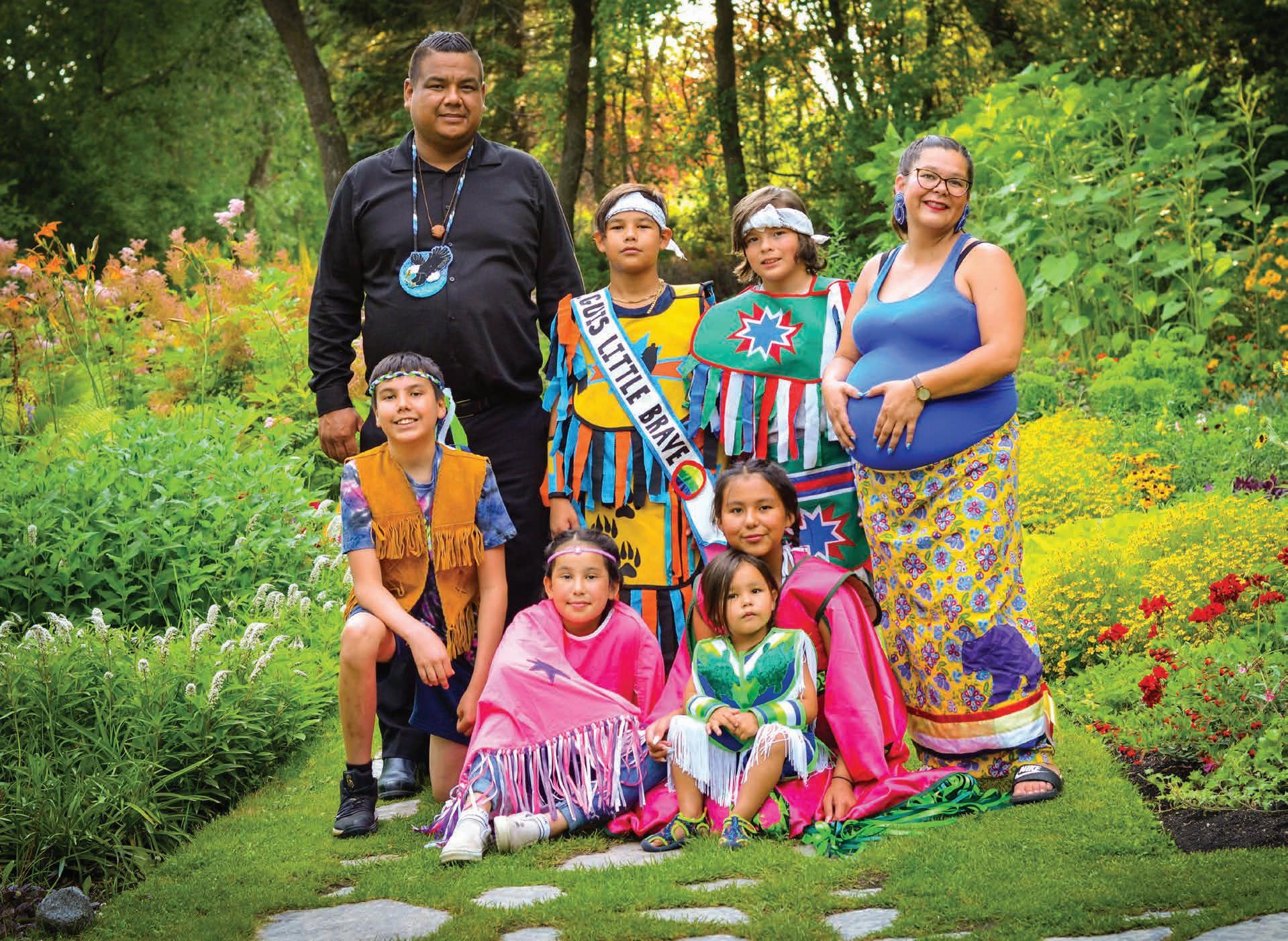
Introduction
About this booklet
This booklet shares stories, cultural practices, and knowledge about parenting and caring for First Nations, Inuit and Metis children aged 6-12 years. The beliefs and practices included in this resource were shared by First Nations, Inuit and Metis peoples living in Manitoba.
The information contained in this booklet is intended to support you in becoming the parent that your children need during their middle years of growth and development. Learning effective parenting skills will have a positive impact on your children’s self-esteem, school achievements, brain development, and healthy behaviours. This includes learning about how you can strengthen your relationship with your children and help them learn about the importance of maintaining strong connections to extended family and community.
Throughout this booklet, you will find highlighted textboxes with links to additional resources that you can check out for more information about the subject matter. At the end of this booklet, there is also a list of organizations that offer a wide range of culturally-appropriate programs, resources and services to help you achieve the best possible outcomes for your children aged 6-12 years.
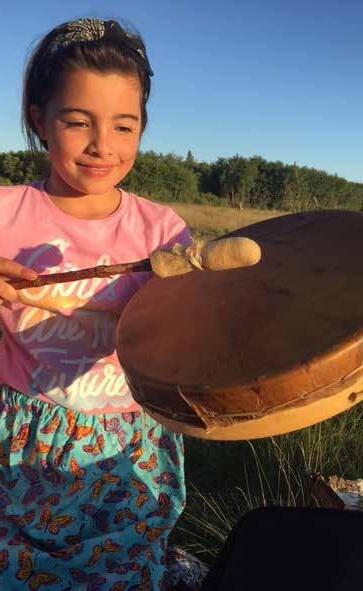
Culturally-appropriate parenting
Traditionally, First Nations, Inuit and Metis peoples learned to parent by watching the actions of their parents, grandparents, and extended family and community relations. Traditional parenting practices were taught from early childhood and continued well into the later stages of adulthood.
Today, parenting practices within Indigenous families generally include a mix of contemporary western approaches to parenting and particular aspects of traditional First Nations, Inuit and Metis cultural childrearing practices that were carried forward from past to present generations.
Culturally-appropriate parenting involves honouring and respecting your personal and family connections to the lands, waters and foods taken from the natural world. It includes exposing your children to their First Nations, Inuit or Metis languages and cultures, which lay the foundation for who they are, where they come from, where they go in life, and where they belong. It also means helping your children grow up in a healthy way by learning about being active every day, eating healthy foods, getting regular health check-ups, and getting to know their body and identity.

nitaawigi’aawaso means to “raise children” in Ojibwe
How children learn
Every day, children learn, grow and develop. Learning and the love of learning begins at home. The teachings your children receive from you and the people around them will help your children learn. They learn from their parents and grandparents, and from other role models in their life, like extended family and community members, family friends, teachers and siblings.
Provide new and positive experiences
First Nations, Inuit and Metis children need parents and caregivers who introduce them to the world, the people in it, and their natural surroundings. Think about the different ways your children can meet new people, try new things and test their abilities. New and positive experiences help children’s brains develop in a healthy way. It also encourages them to trust themselves and be more willing to try new things. It is important to include new and positive experiences and opportunities for learning in your children’s daily life.
Promote a positive attitude
Children learn more from what they see you do than from what they hear you say. Your outlook can make a huge difference in the health and well-being of your children. When you eat well, exercise regularly, and express your emotions in a healthy way, children follow your lead. They watch how you spend your free time, what your attitude is toward work and education, how you talk to and about other people, and how you show and deal with your emotions.
By watching your attitude and behaviour, children learn how to get along with other people. They learn about the value of lifelong learning and about working hard, regardless of whether your work involves paid employment or taking care of everyday tasks around your home. More importantly, children learn that they are a priority to you. When you make a mistake, let your children know you made a mistake but have learned from it. Talk about what you learned from your mistake. This teaches your children that you are learning too.


tepwewakennimitisowin means “confidence” in Ojibwe Cree
Children with additional support needs
Many First Nations and Metis Elders say that all children are a gift to their community. Inuit also believe that children are at the centre of the family and central to all of life, past, present and future. First Nations, Inuit and Metis peoples say that all children need to be treated with care and respect. They need someone to be good to them and to show them – and tell them – that they are loved, every day. Children with intellectual or developmental disabilities are seen as people to learn from rather than as people who are a problem. They are present to teach something to the community.
Get help
Children develop in their own way, but there are common patterns, ages and stages of child development. As a parent, you are part of your children’s larger circle of supports, which may include extended family members and Elders. If you think your children may need additional support with learning, hearing, speaking, or any other part of their physical, mental, emotional or spiritual development, talk to your family doctor, community health nurse, or family support worker about your concerns. Your children’s school may help to find out if they have additional support needs.
Manitoba First Nations Education Resource Centre, Special Education Program
Phone: 204-594-1290
Toll Free: 1-866-319-4857
mfnerc.org/resource/special-education
Learning that a child has additional support needs can cause some parents to feel shocked, upset, depressed or disappointed. You may feel angry or defensive if someone tells you that there may be something wrong with your children. It is important for you to make sure your children’s additional needs are met. There are services throughout Manitoba to help with caring for children with additional support needs. Your family and community also may provide a good support system.
“I was 26 years old when I found out I was going to be a mother for the first time and my whole life changed … I had a baby girl, who I named Rachel … Rachel sustained a major brain injury from traumatic birth … It’s been a long twisting road raising a little girl with disabilities … a specialist told us she probably wouldn’t be able to attend school like the other children … Despite having a brain injury, epilepsy, a hearing loss in the left ear and mild cerebral palsy, Rachel is a miracle in every sense of the word … She loves to read, play music, sing, tap dance, ride horses, snowshoe, travel, take pictures, watch movies, advocates and fundraises for people with disabilities and illnesses, and socializes with people. Most importantly, Rachel is my greatest accomplishment in life. No matter what challenges life throws at her or myself, we never give up.”
-Jennifer Laviolette

“Jordan’s Principle was developed to meet the needs of First Nations children with disabilities. It ensures that we don’t have to put our children in care to make sure that they have the same right to health programming as any non-First Nations child. The implementation of Jordan’s Principle is crucial in making sure that every child has equal access to health services and programs they need wherever they live.”
-Gilbert Fredette
First Nations Child and Family Caring Society, Indigenous Knowledge Portal fncaringsociety.com/knowledge-portal
Inuit Child First Initiative itk.ca/projects/inuit-child-first-initiative
Jordan’s Principle Call Centre Toll Free: 1-855-572-4453
sac-isc.gc.ca/eng/1568396296543/1582657596387
Be patient
Parenting children with additional support needs can be an enriching experience that brings great joy to your life. Patience is important. It may take time for you and your children to learn new skills for dealing with your children’s additional support needs. With proper care and support in place, children with additional support needs can overcome incredible obstacles. Love your children for who they are and for the gifts that they bring to your life.
Appropriate Educational Programming edu.gov.mb.ca/k12/specedu/aep/index.html
Fetal Alcohol Spectrum Disorder (FASD) gov.mb.ca/fs/fasd
Information for Manitobans with Disabilities: For Parents of a Child with a Disability gov.mb.ca/fs/imd/childwdisab.html
Working Together: A Handbook for Parents of Children with Special Needs in Schools
edu.gov.mb.ca/k12/specedu/parent/handbook.html el k’es su tle’ means “courage” in Dené


Parent in the present
As a parent, the present is your place of strength. All of your thoughts, feelings, ideas and choices happen right now, in the present. You cannot do anything to change what happened in the past, but you can learn from it and grow to become the best parent that you can be for your children. You do not have control over the future, but you can plan for it. You can start by changing how you parent, now.
Make a big impression
Parenthood is one of the most important and challenging journeys of your life. As a parent, you make a big impression in the life of your children. You are their first, most important and most lasting teacher in their lives. You also are their protector, role model and nurturer. Your children turn to you, first, to meet their needs.
Not all children are the same. They have unique personalities, different interests, and diverse needs. Parenting also is a very individual experience. Some parents find they have a lot to learn about parenting, especially if they did not have a positive role model to learn from when they were growing up.

Be involved
Most parents, today, want to be more involved in their children’s lives, in more ways than ever before. They want to be there for their children and take part in raising them. Parenting may feel like a big responsibility, but the rewards are enormous. Even if you are not the primary caregiver of your children, it is important for you to be as involved as possible in parenting your children. You can choose to learn all you can about your parenting role and about what you can offer to support your children’s growth and development. Everything you do with your children is a gift. Love and cherish each of your children. Expose your children to a variety of positive life experiences.

ataata means “my dad” in Inuktitut
Teach and guide your children
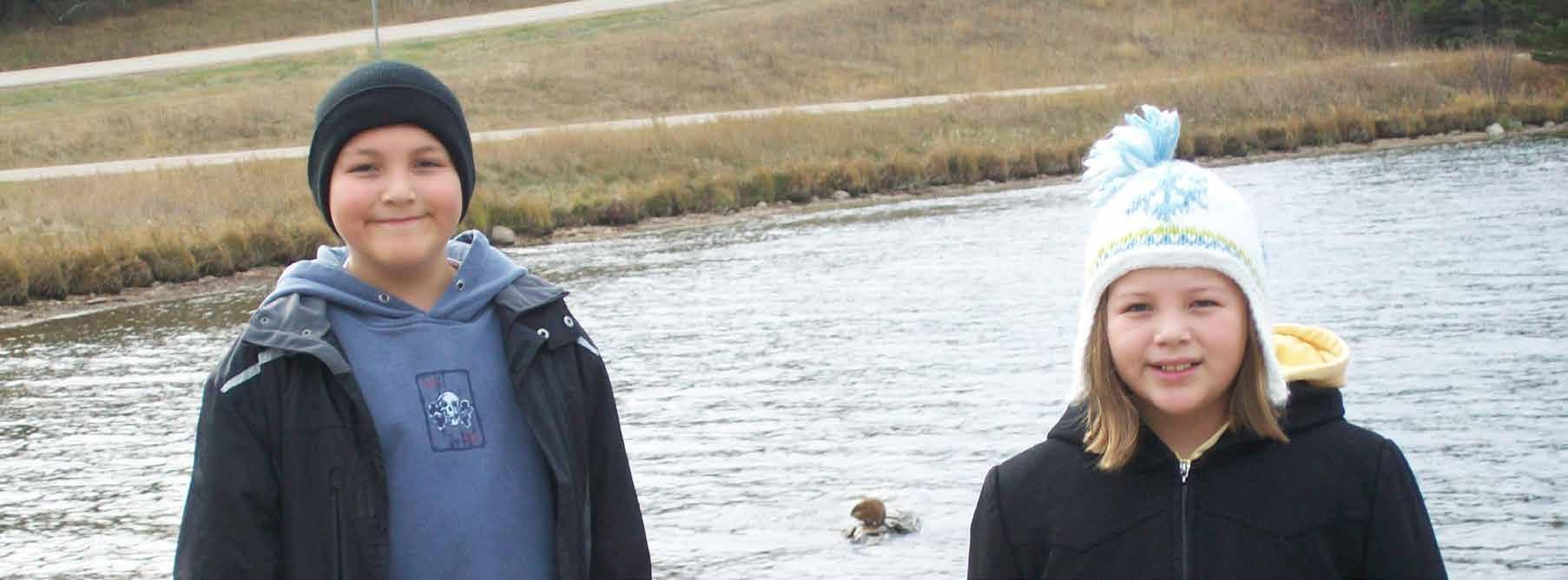
First Nations, Inuit and Metis peoples have different but similar beliefs about the spirit and existence of children. Across all Indigenous cultures, parents and caregivers of children have a responsibility to teach and guide children to live a good life, as responsible and capable human beings. Parents and caregivers also have an opportunity to develop strong and healthy relationships with children. The teachings and guidance that you give to your children will help them grow up to be happy, caring and self-confident, with good self-esteem, strong values, respect for others, and the skills they need to solve problems.
Practice positive parenting
Think about what you can do to be your children’s first and best teacher, and what you can do to help your children learn, feel loved and be happy every day. Here are some suggestions:
• Read books about parenting children in the middle years (ages 6-12 years) or watch videos that help and inspire you to be a loving, nurturing, respectful, understanding and supportive parent to your children.
• Be actively involved in your children’s daily routines, such as meals, school and playtime activities, homework and bedtime. Be consistent with routines and expectations.
• Get the help you need from family, friends or local programs and services. Seek out wise and healthy people who can support you in your parenting.
• Practice making your home a loving, comfortable and safe environment for your children. Allow only safe people to be in your children’s lives. Get to know who your children’s friends are at school and who they talk to outside of school. Teach your children about safety and injury prevention.
My Child in the Middle Years: A Parent Resource edu.gov.mb.ca/k12/midyears/parents/resources.html
Nobody’s Perfect Parenting Program and Parent Resources nobodysperfect.ca/provincial-contacts/manitoba
Safe and Caring Schools edu.gov.mb.ca/k12/safe_schools/index.html
“[What] worked with me to help with calming my child is to let her do it … I let her get her emotion out, and then I ask her, ‘Now, do you want a hug?’”
-Carla Cochrane
Respect each other as co-parents
Children learn about relationships from their parents. One of the most important things parents can do to support the healthy development of their children is to work on having a respectful relationship with each other. Children do well when they see their parents working together. Whether you are living together or not, it is important for parents to provide balance in their children’s lives and guide them in a good way. It also is important that parents are on the same page when it comes to boundaries, discipline and roles within the family.
Careful guidance builds a close, respectful relationship with children. It also teaches children how to be good parents and strengthens the generations that follow. Think about how you talk about and relate to your children’s other parent. Show your children that you respect their other parent by talking and interacting with their other parent in a healthy way. By acting respectfully toward each other as parents, your children also learn to think and act respectfully toward their parents and other members of the family.
For the Sake of the Children Program for Parents gov.mb.ca/familylaw/parenting/for-the-sake-ofthe-children.html
Provide life necessities
Children need a safe place to grow up healthy. This includes things like adequate housing and sanitation, good fitting clothing and footwear that is appropriate for the weather, food and water, education, adequate playtime, and healthcare. It also includes things like love and respect, guidance, security, encouragement and attention.
When children’s needs are met, they learn to trust that you have their best interests in mind, at all times. Your local friendship centre, family centres in schools, and community resource centres offer free programs and services to help with parenting and providing for children.

Understand unwanted behaviour
Behaviour is children’s way of communicating with the people around them. Children may behave in a negative way if they are feeling tired, stressed, hungry, worried, afraid, or even full of energy. They may feel anxious or overwhelmed and need your attention. Children sometimes show how they are feeling by using behaviours you do not want.
Children learn about boundaries and about what happens when they test other people’s limits. It is more useful to guide children’s energy into wanted behaviour than to discipline them for unwanted behaviour. For example, energetic children can be taken outside to play, instead of feeling restless inside their home. Setting daily routines and having positive interactions with your children are important and helpful in keeping them calm.
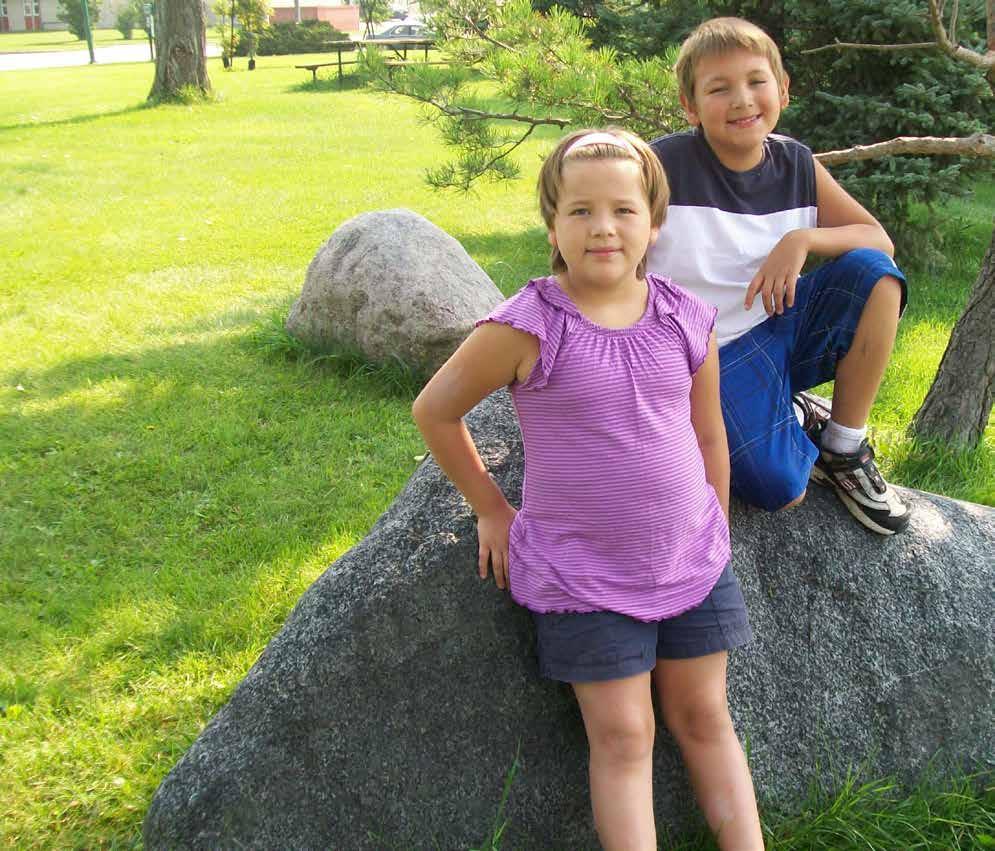
Provide positive guidance
Children want to please their parents and caregivers. They need to know what they can and cannot do. Role model positive behaviour for children. Positive guidance reinforces good behaviour. Guiding children’s behaviour is effective when it is based on their stage of growth and development, what they can do, and their personality.
Guiding children’s behaviour should always be positive, consistent and fair. It should never involve physical or verbal violence such as yelling, hitting, threatening, name-calling, or any other actions that will cause children to feel any type of shame, fear, pain or discomfort. These actions raise children’s stress level and prevent them from learning. It also teaches them that it is okay to do the same to others. Never hurt or harm children.
Handling problems well, as soon as they come up, is an important part of guiding children’s behaviours. It is best to prepare children for good behaviour before there are problems. This gives children the skills they need to do alright in the world. Teach your children about communicating, getting along with others, knowing what is expected, and how they can deal with stressful situations.
Offer praise
Tell your children what they have done well. For example, praise them when you see them getting along well with others or thank them when they help out without being asked.
It is better to use praise or thank you than to buy children gifts or give rewards for positive behaviour. When children hear positive praise comments, they want to do more of that good behaviour because it makes them feel better about themselves. This also helps to build their self-esteem.
Use time-in
Use time-in to encourage good behaviour through positive interactions and by talking with children when they are misbehaving. Instead of distancing yourself from your children when they are having a hard time, focus on their needs and the source of their unwanted behaviours. This can help you and your children figure out, together, what is wrong and how to make things better. For example:
• Talk about feelings and emotions (yours and theirs). Ask, “Are you mad? Are you feeling sad or afraid?”
• Give your children a hug and show them – and tell them – that you care about them and the way they are feeling.
• Talk about different ways to deal with the same kind of problem, next time.
Children often become flooded with emotions and cannot remember rules or focus on others until they get their feelings under control. Being calm enough yourself and sitting near or with your children until they calm down, and then talking about what happened will help your children to feel safe. They will know that they can count on you to be there for them and are ready to learn about what got them upset.
Use redirection
Redirection means changing unwanted behaviour to more appropriate, desired, behaviour. Redirect children’s thinking and actions when their behaviour is not okay. For example, if your children are jumping on the couch, you can tell them that it is unsafe to jump on the furniture and ask them to do their jumping outside. When redirecting your children’s behaviour, always use a calm voice and explain why and how you would like your children to act differently.
Use distraction
Use distraction as a way to draw children’s attention away from something that is upsetting them to a new activity or conversation that is more pleasant for them. For example, if your children are upset because it is time for bed, but they are in the middle of playing or doing something else, you may be able to distract them by talking about your plans for the next day or by telling a funny story about something that happened when you were a child.
Do not use distraction when children are really upset. Instead, try offering them a choice, such as going outside, doing a craft, or reading together. Soothe your children until you can see they are calm, and THEN discuss what was going on before.
Offer choices
Offering choices to your children is another strategy to change unwanted behaviour. Giving children choices helps them to think things through and make good decisions. It helps them learn to understand and manage their behaviour. For example, an 8 o’clock bedtime is not negotiable, but giving children the choice between whether they want to brush their teeth before or after they get into their pajamas, or have a story or a song before lights out, gives children a sense of control over their actions. It also helps to set boundaries on children’s behaviour.

keesha kee tin means “I love you” in Michif
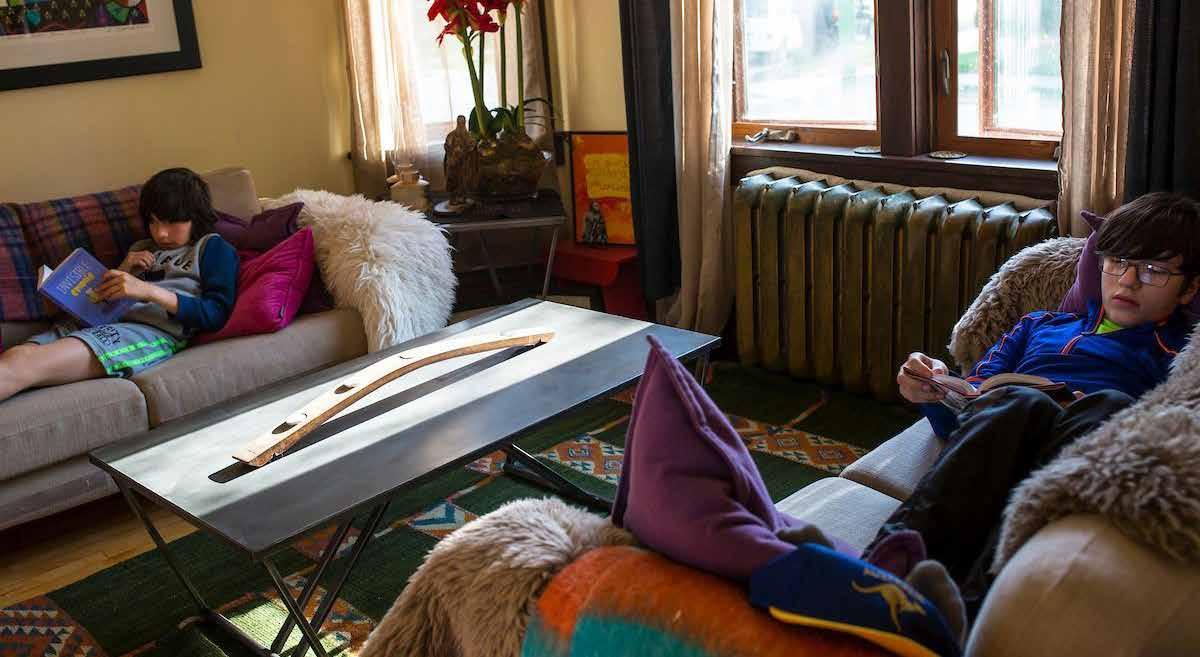
Bond with your children
Bonding is the connection to their children that parents start to develop after their children are born. It continues throughout their lives. There are things parents can do to strengthen their bond with their children, such as caring for them in a way that makes their children feel loved, valued, safe and secure. Children bond with people who model good behaviour and a positive attitude. They feel comfortable with people they trust and respect. Think about what you can do to strengthen your connection to your children.
Honouring the Sacred Bond – Ma Mawi Wi Chi Itata Centre Inc. Family Group Conferencing mamawi.com/family-group-conferencing

Spend quality time together
Spend as much time as possible with your children. The more time you spend with your children, the more confident and comfortable you will become as a parent. Being a parent takes time and practice, but it is not only about the amount of time you spend with your children that is important. The quality of the time you spend with your children is also important.
Children watch how you spend your time. They learn about the things that matter most to you. By spending time with your children and giving them your full attention, they learn that they are important to you and worthy of your time. Spending time together also helps to develop a healthy relationship between you and your children.
When you spend time with your children:
• Do things that interest your children. Involve them in things that you like to do.
• Teach them how to throat-sing, go to pow wow clubs, or attend Metis jigging lessons.
• Go outdoors or onto the land as much as possible. Get away from the television and video games. Put away the cell phones and other electronic devices.
• Learn more about your children’s life outside of your home. Get to know more about their friends. Keep up with what’s happening in their life and how they are doing in school.
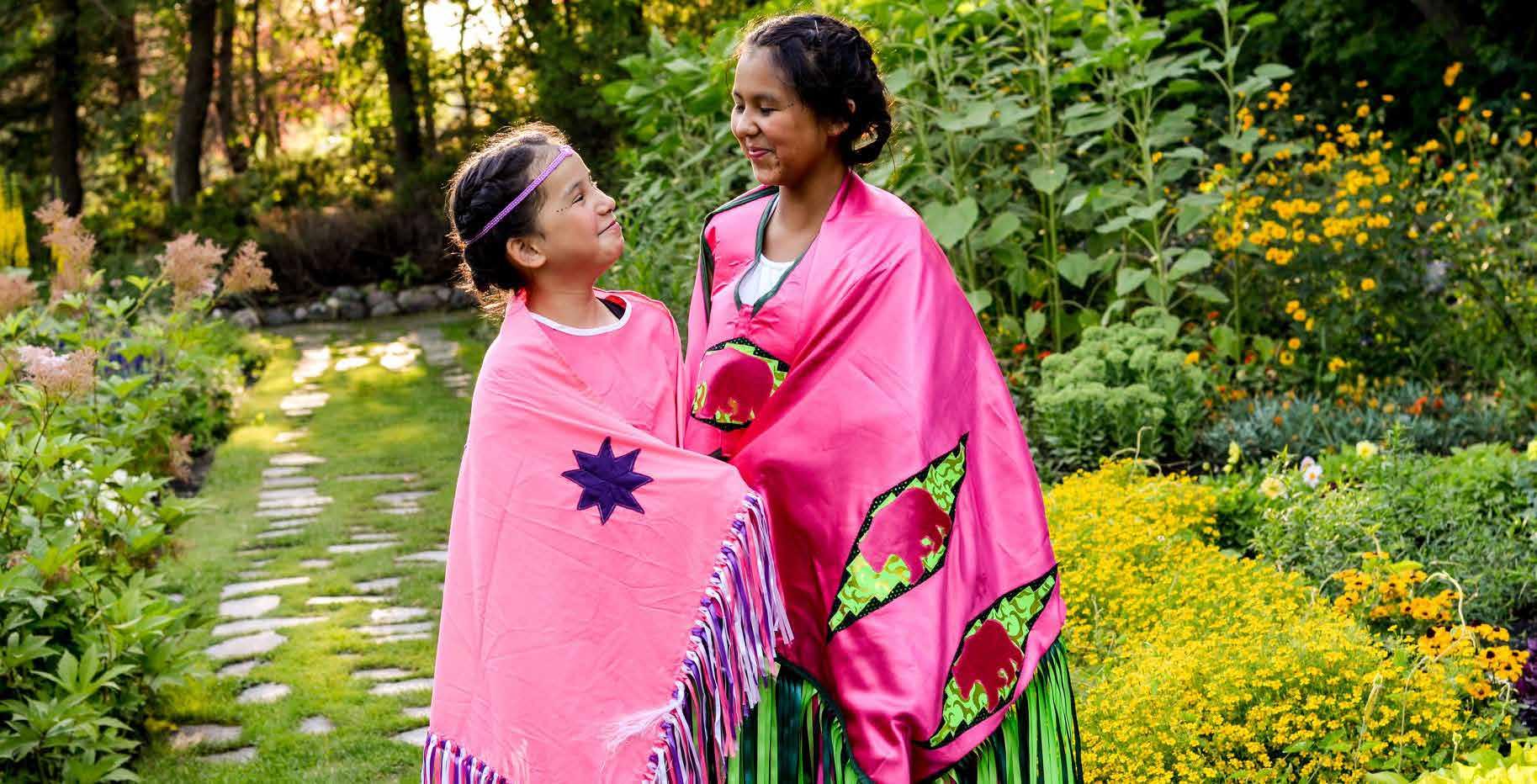
“I make sure to tell my child that I will always love her, no matter what. I tell her to remember that if I ever get upset, to remember this: ‘Sometimes parents can become upset for whatever reason. If I do, it is because I am trying to guide the best that I can. I will always be here for you.’”
-Carla Cochrane
Stay connected
It is tough when parents are not able to see their children. Even if you are not living with your children, spend as much time as possible with them. If you have plans to spend time together, do everything possible to follow through with your plans. Stay connected to your children. If you have to miss plans with your children, make sure you let your children know that you love and accept them. For example:
• Let your children know ahead of time that you have to reschedule your plans with them.
• Explain to them that they are very important to you and that you look forward to your next chance to do something together.
• Tell your children that even though you cannot be with them right now, you want them to know that you love them, miss them, and think about them every day.
Show affection
Children need to know that they are loved by their parents. They need to hear their parents say, “I love you.” They also need to be hugged by their parents, regularly. This can be difficult for some parents, especially if they did not grow up in a caring home with their family and community to support them. Some parents are not comfortable with emotions. Even if you have a hard time expressing your emotions, you can show your children that you care about them through your actions. Here are some ideas:
• Respond in a positive way to your children by using kind, caring and loving words.
• Use a calm, gentle and caring voice when you talk to your children. Do not yell or scream at your children when talking to them.
• Use actions that show how much you love and respect your children. Laugh and talk with them. Tell them stories. Sing songs to them or with them. Talk and sing in your Indigenous language.
When you consistently respond to your children’s needs in a loving, caring and attentive way, they learn that you provide comfort, safety and security. Your children know that you will be there for them when they need your help. Your connection with your children will remain strong and stay with them throughout their lives.
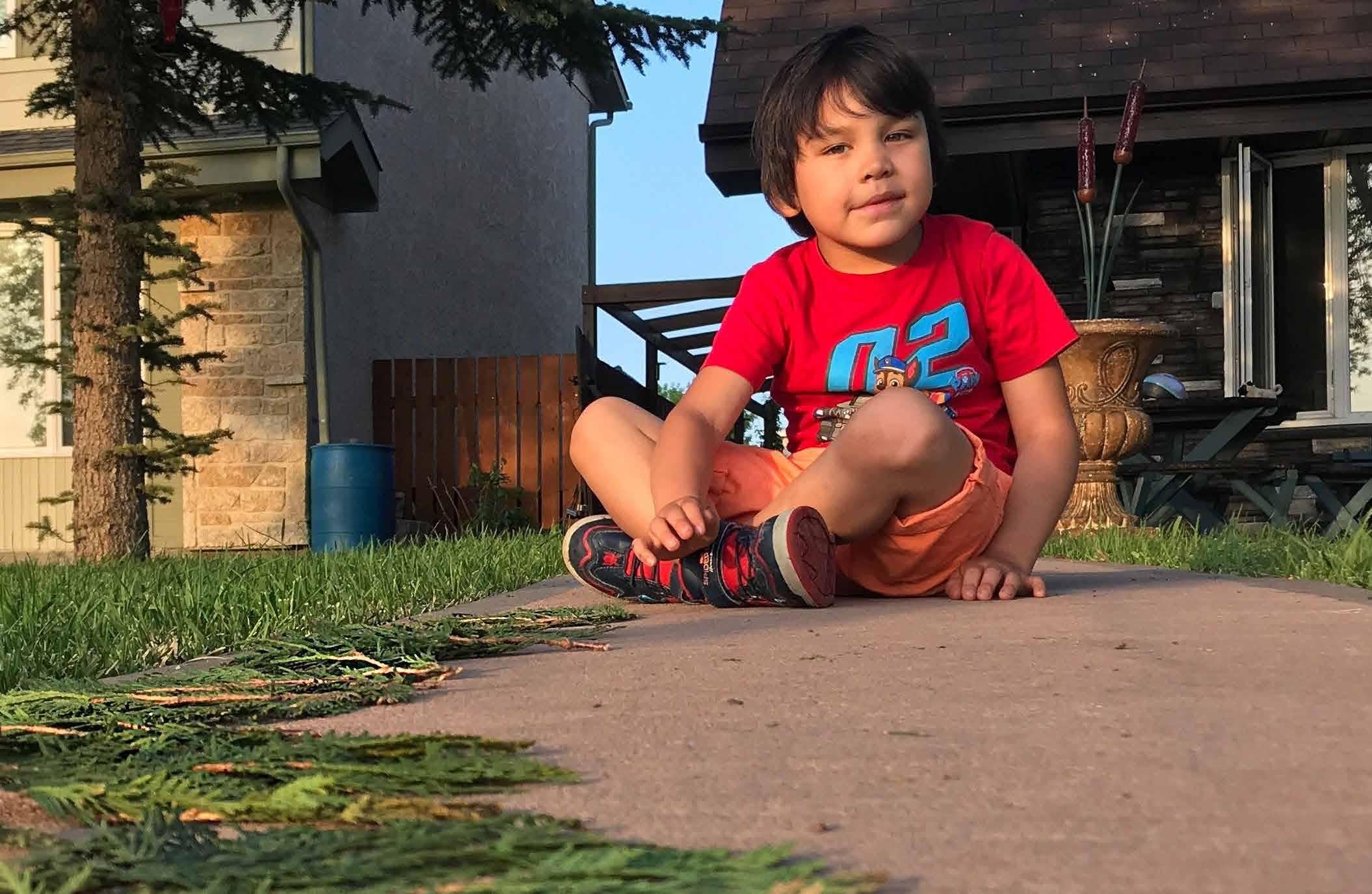
Talk about feelings and emotions
Emotions can have a powerful impact on children’s learning and development. Children are happier and ready to learn when they feel emotionally safe and secure. By helping your children explore their own feelings and understand the emotions that affect their actions, you also help them learn to identify the feelings and emotions of others.
If your children need additional support, they can reach out to support counsellors who are available to offer help at any time of the day or night.
Kids Help Phone
Toll Free: 1-800-668-6868
Text: 686868
kidshelpphone.ca
KidThink
Phone: 431-388-5373
kidthink.ca
Cedar is one of the Four Sacred Medicines that some Indigenous cultures, particularly First Nations and Metis peoples, use to communicate with Creator and the Spirit World. The other sacred and powerful medicines include tobacco, sage and sweetgrass. Cedar is used to purify the home and offer protection. Because of its many valuable medicinal properties, cedar is also widely used for healing and cleansing purposes.
Offer a safe place
All children need a safe place to turn to when they are feeling hurt, frightened or upset. You can provide a safe place for your children by stopping what you are currently doing, listening to your children with your full attention, and comforting them when they are upset. Try to hear what your children are NOT telling you in words.
Build children’s resilience
Resilience is the ability to get through life challenges by finding ways to bounce back and thrive, in spite of these challenges. Resilience is built in early childhood and continues to develop throughout life. Children need to practice having some stress, with supports, in order to become resilient. When we pass on our fears to our children, it keeps them from being able to try new things. People who respond to hardships with resilience are healthier, live longer, are happier in their relationships, are more successful in school and at work, and are less likely to get depressed.


anaana means “my mom” in Inuktitut
Family and community connections
Traditionally, First Nations, Inuit and Metis parents were responsible for the spirit of the child. Children were loved unconditionally. Everyone in the community shared responsibility for teaching and watching over the children in the community. Children were parented in a healthy and respectful way. They developed strong connections to their family and community. They knew who they were and where they belonged in society.
How we live together as a family and community has changed over time. Families may have moved away from their traditional lands, but keeping connected to family and community is important because it helps children learn about their identity and develop a strong sense of belonging. When children know who they are and feel like they belong, they see value in life and can cope with strong emotions.

Connect to family
Today, there are many different types of families, large and small. There are single-parent and two-parent families, blended families, foster families, and families that include several generations. Parents may be biological or adoptive, extended relatives, step-parents, young or elderly, and single or married. They may be gay, bisexual, two-spirit, transgender, queer or straight. Each family is different, and each child has different needs within the family.
Families provide a strong circle of support for you and your children. Think about what you can do to connect your children to their family. Here are some suggestions:
• Show your children pictures of family and tell them stories about their close and distant family members.
• Attend or have family meals or events that include your children’s grandparents, aunts, uncles, cousins, adult siblings or other relatives or close friends of your family.
• If in-person events cannot happen, set a regular time when you and your children can call, Zoom, Skype, or FaceTime with relatives. If you do not have phone or internet services, use this time to mail a letter, a drawing, or a photo to them, from your children.

Connect to community
Connecting children to their First Nations, Inuit or Metis community creates a source of comfort, belonging and support for them. A community can be the place where you live, your neighbours, the groups of people you know, or the local services you access regularly. Children who are connected to the people and services in their community learn to take pride in who they are and where they come from. More importantly, they learn about the values, traditions, languages, and practices of their community. Help your children learn about their community:
• Attend community sporting events with your children.
• Participate in community events with your children, like craft shows, community feasts, community camps and cook-outs, and First Nations, Inuit and Metis cultural celebrations.
• Learn with your children about the history and traditions of your community from Elders and other Knowledge Keepers in your community. You can become connected to Elders through your local friendship centre, healing lodges, communitybased programs, and First Nations, Inuit and Metis organizations.

koopije means “great-grandmother” in Anishinaabe
Create your own traditions
Most traditions are practiced around holidays or at special times of the year, such as hunting or seasonal camping on the land. A tradition can be something that the whole community practices or it can be something that is special only within the family. Having traditions is a great way to give children positive memories of their childhood. It creates closeness and belonging in families, and gives families something to plan, look forward to, and do together.
You can create your own traditions with your children. Make your family traditions special to your children, and something that everyone in the family enjoys. You likely will find that your children will remember these traditions, talk about them often, and practice them with their own children when they grow up. Here are some ideas:
• Take a picture on the first day of school, each year.
• Turn off all electronic devices and have family game night on Sunday evenings.
• Go out onto the land for a family picnic on the first day of summer.
• Have a birthday routine that is practiced on all family birthdays.
• Decorate the Christmas tree together, on the first Sunday in December. Play Christmas music, drink hot chocolate, and tell family stories while decorating the tree.
• Make up your own holidays, like Love Your Kids Day or Explore Nature Day.
Education and learning
Get involved in your children’s education
Parents who are involved in their children’s learning make a positive difference in the lives of their children. When parents are involved in their children’s education, they become more comfortable within the school environment, gain more confidence in their skills and abilities as a parent, and feel more capable of helping their children learn. When parents get involved in their children’s education, their children are less likely to experience absenteeism and have higher grades, better social skills, and improved behavior. Children can also develop a lifelong love of learning when their parents are involved in their education.
Manitoba Inuit Association – Training, Employment and Education
Phone: 204-774-6848 manitobainuit.ca/training-employmentand-education
Remote Learning MB mbremotelearning.ca
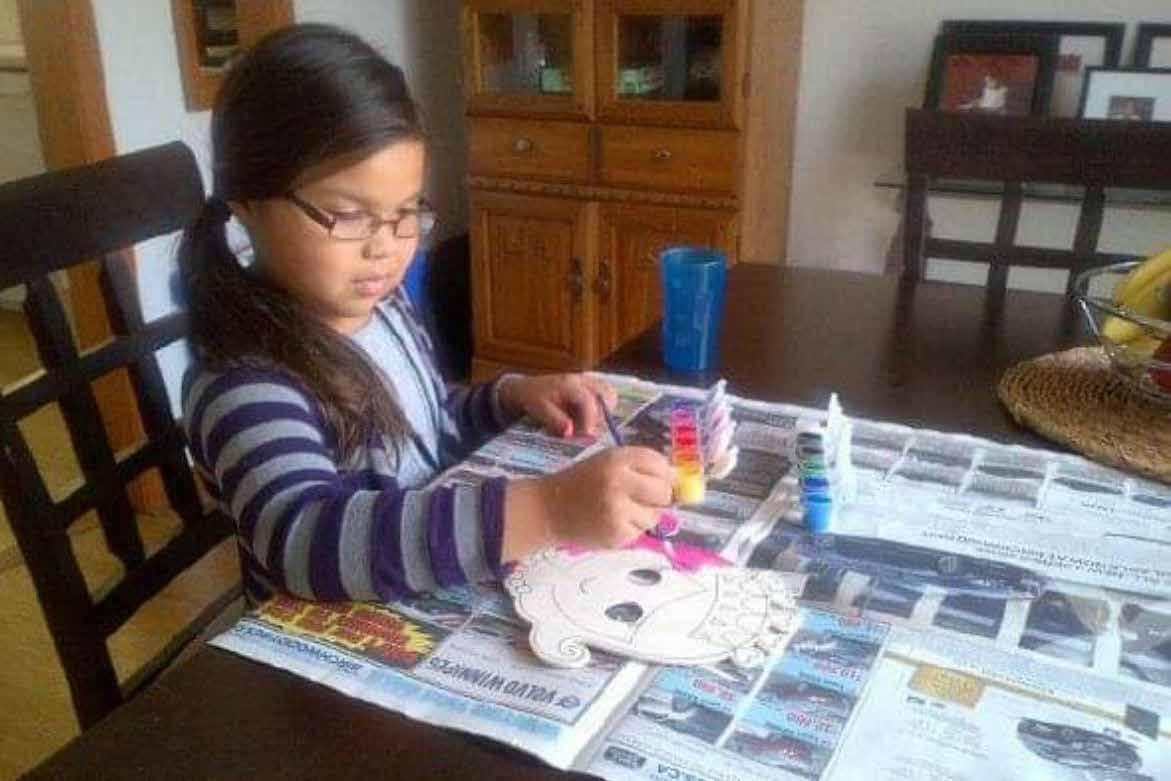
There are many ways for parents to get involved in their children’s education and help with their children’s learning at school:
• Visit your children’s school regularly, get to know their teachers, and find out how your children are doing at school.
• Participate in school activities with your children. Visit their classrooms and share stories about your family, community, and traditions such as crafts, gathering medicines, fishing and hunting.
• Follow your children’s interests and talk about what they are learning in school. Help your children with homework, making lunches, and getting to school on time.
• Talk with your children about their school experiences. Ask them about specific things, such as gym, music, special guests, and their friends. Listen with interest and respond to what they have to say.
• Watch for any changes in your children’s eating, sleeping, energy and behaviour. Ask your children what they need from you to help them with their learning at school.
• Get to know your children’s friends and talk with your children about things that are happening in school and with their friends.
Helping your Child Succeed in School: A Guide for Parents and Families of Aboriginal Students edu.gov.mb.ca/k12/docs/parents/ab_guide/index.html
Information for Manitobans with Disabilities: Education – Programming and Planning gov.mb.ca/fs/imd/edu_progr.html
My Child in School: A Resource for Parents –Curriculum Information edu.gov.mb.ca/k12/mychild/index.html
My Child in the Middle Years: A Parent Resource edu.gov.mb.ca/k12/midyears/parents/index.html
Help your children learn outside of school
Even though children learn many new and important things in school and from their friends, parents are still their first, most important, and most lasting teachers in their lives. Children need parents to teach them about family, friendships, the natural world, and traditional practices. They need their parents to teach them about life. Parents who encourage their children to learn outside of school make a positive impact on their children’s outcomes.
Here are some ideas to help with your children’s learning, outside of school:
• Go for family walks or bike rides with your children, and teach them about the community they live in and the natural environment.
• Go to the library and take out books together. Help your children develop their reading skills and influence their love of reading. If you have trouble with your own reading abilities, take classes to develop your own reading and literacy skills.
• Go to art galleries or museums in your community.
Directory of Certified Adult Literacy Programs & Adult Learning Centres edu.gov.mb.ca/all/directory/index.html
Helping Your Child Learn to Read: A Parent’s Guide edu.gov.mb.ca/k12/docs/parents/learn/read.pdf
Information with Manitobans with Disabilities: Education – Home/School Connection gov.mb.ca/fs/imd/pubs/edu_home_sch.pdf
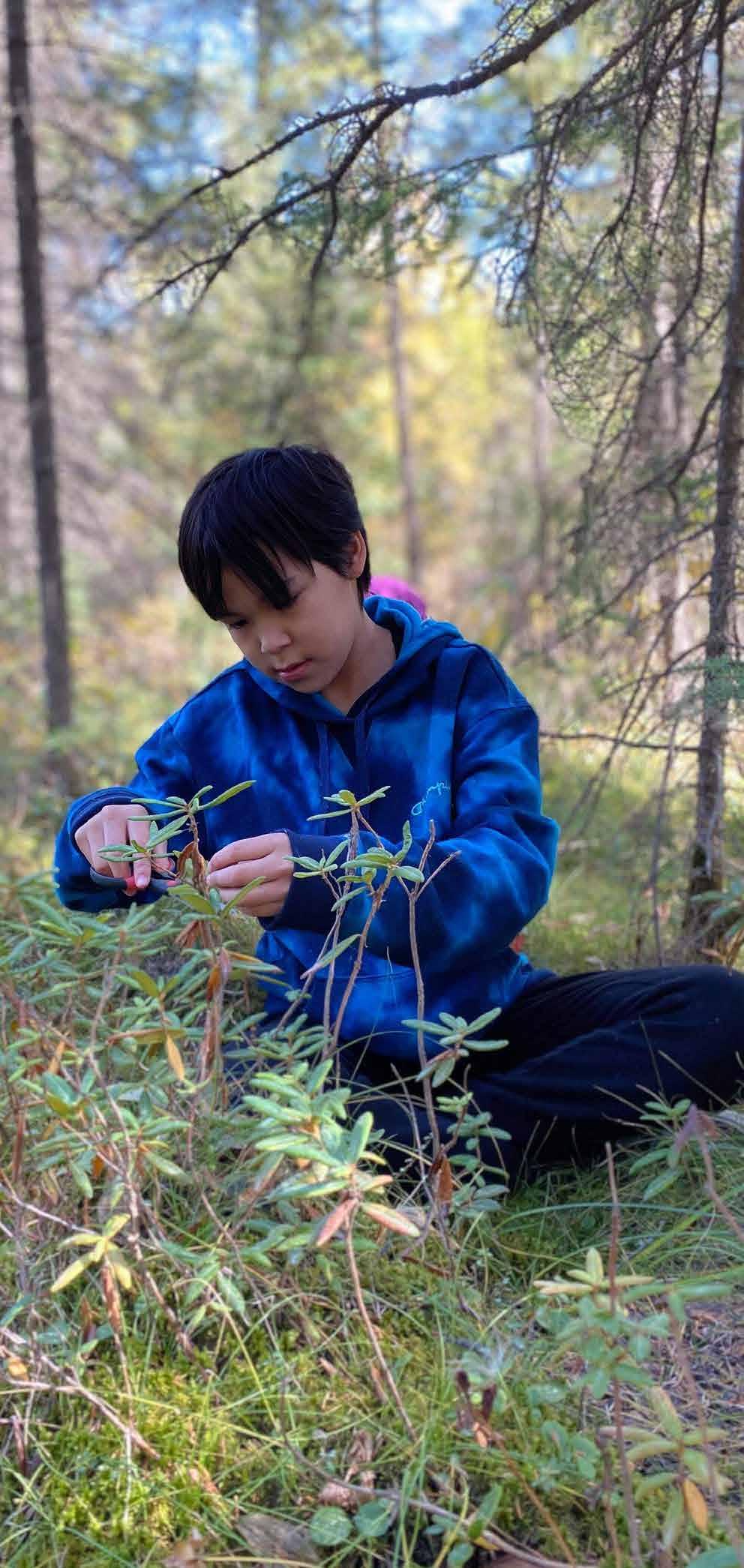
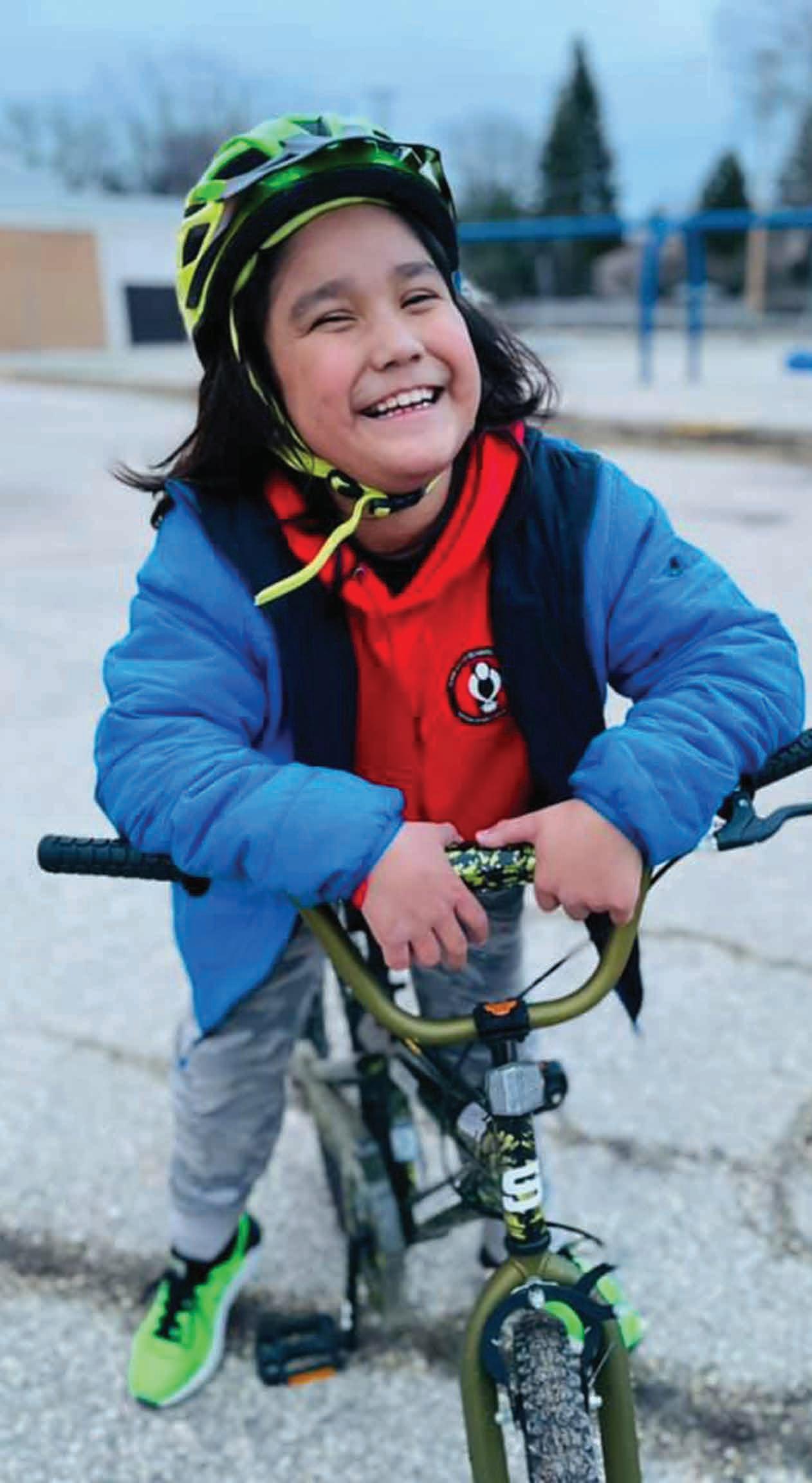
Allow time to play
Play is the natural way that children learn. When they play, children learn about the richness of the world, practice life skills, and develop connections to their natural environment. Play helps to build trust and cooperation in children, and it improves children’s chances of success in school and later in life.
Through play, children strengthen their ability to think, solve problems, use their imagination, be creative, make decisions, and take safe risks. They also learn about boundaries and how to manage their behaviour, build social skills, and develop connections to family, community and the natural world.
Children need the time and space to play, both inside and outdoors, every day. Play activities should be fun and enjoyable for children, not competitive and upsetting for them. Children do not need to have organized games with rules to follow, and they do not need expensive toys or gadgets to play. Children need the freedom to be active and explore their interests.
Provide meaningful play opportunities to strengthen your relationship with your children and enhance their learning and development.
• Take your children out on the land, regularly and often. Explore nature. Role model a curious attitude and make comments that deepen your children’s thinking, such as asking them if they can hear different bird songs.
• Bring your children to programs where they can interact with their peers and learn how to get along with others.
• Play with your children in the snow or rain. Dig in the dirt. Collect leaves, rocks, shells or pinecones. Watch what your children are doing and join in. Follow their lead (as long as they are safe).
Nature Manitoba
Phone: 204-943-9029 naturemanitoba.ca
Connect to language and culture
Children look to their parents to teach them about life. A great way to do this is to connect children to their traditional languages and cultural heritage. Give your children amazing stories that they can learn from and share with their own children when they become parents.
• Learn about your past and where you came from. Share what you learn with your children. Tell your children about their ancestors, grandparents, and other family and community relations.
• Engage in cultural practices with your children. Share personal teachings or learn together about your traditional practices, such as fishing, hunting, trapping, berry picking, harvesting medicines, drumming, jigging, throat singing, drawing or painting, or playing a sport.
• Take your children out on the land. Teach them about respecting animals, nature and our waters.
• Teach your children their First Nations, Inuit and Metis language. If you are learning your First Nations, Inuit, or Metis language, share with your children what you are learning or learn together how to speak your language.


Support your children’s healthy development
Here are some additional helpful hints to support your children’s learning, growth, and development:
• Show your love for your children and encourage them to do the same. Hug them often. Tell your children, every day, that you love them.
• Teach your children with love, patience, and a good understanding of their learning interests and abilities.
• Involve your children in special family celebrations and community traditions to build cultural pride and a sense of belonging in your children.

nôhtawiy means “my father” in Cree
Routines and responsibilities
Children thrive on structure and routine. Consistent parenting practices and daily routines promote healthy habits in children and help children feel safe and secure. For instance, family meal time is an important part of a healthy family routine. It is a time to connect as a family. Turn off the television during meals so you can talk with your children without any distractions. Listen to the stories your children want to share with you. By focusing on your children and talking together as a family, you teach your children about social skills, family and caring.
By expecting children to help out with household chores, care for other people or pets, and finish tasks, parents teach children how to solve problems and develop the confidence and capacity to reach their full potential.
Be precise and predictable
Children do best when they know what to expect and when to expect it. They need to know what their parents expect from them and what they can expect from their parents. Praise your children when they do well or when they try their best to do something. Teach your children about responsibility and respectful behaviour. Children need to feel safe making mistakes and should not be afraid to ask questions.

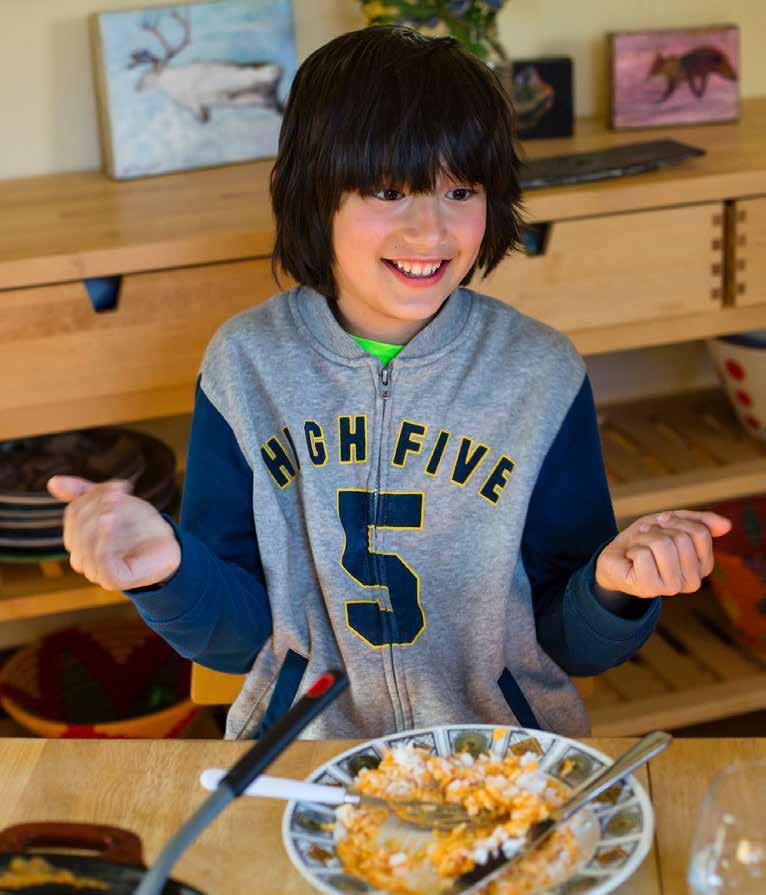
Set reasonable expectations
Every child is different. Even in the same family, children have their own personalities and enjoy different things. All children need special attention and time to follow their own interests. Learn to understand the unique personality and interests of each of your children. Respond to their individual needs and abilities. Make sure your children’s roles and responsibilities within the family fit with what they are capable of doing, such as picking up clothes and putting them in a hamper, clearing and setting the table for dinner, helping with cooking, or watching younger siblings while you do a quick task nearby.
Children should be able to complete their tasks with minimal help. Expecting too much from your children can put unnecessary stress on them, such as expecting your six-year-old to cook a hot meal on their own. At the same time, if your expectations are too low, your children may not learn how to be responsible or push themselves when things get hard.
Build capacity
Give your children household tasks that build their skills and abilities. Turn these tasks into a game and make it fun for your children. Be prepared to step in and offer guidance if your children need help. Acknowledge their efforts and encourage them to keep trying. Praise your children when they have completed their tasks. Continue giving them new tasks to challenge their abilities and develop their lifeskills. Here are some ideas:
5-7 YEARS
• Sort laundry
• Keep school work and backpacks organized
• Water plants
• Get their own snacks from low cupboards
• Help with making school lunches
• Feed pets
• Set and clear the table
• Make their bed
• Sweep the floor
• Bring in mail
Give clear guidance
7-11 YEARS
• Help plant and harvest garden vegetables
• Peel potatoes, grate cheese, and other simple mealtime tasks
• Prepare microwavable dishes
• Vacuum
• Fold and put away laundry
• Change bed sheets
• Wash the car
• Sew on a button
• Bring in wood for the woodstove
Children generally try to do the best they can because they want to please their parents. To help with doing their best, children need understandable guidance from their parents. Give clear instructions when you ask your children to do a task. For instance, instead of telling your children to clean up their room, be specific and ask your children to put their toys in the toy box and their dirty clothes in the laundry basket. If necessary, show your children how to do the tasks you are asking them to do, like setting the table, putting away groceries, or taking out the garbage.
Be flexible
Everyday routines, like eating breakfast, having dinner as a family at the table, and taking a bath or shower before bedtime, are important because they give children the structure and stability they need to feel safe and secure. Routines are predictable because they happen regularly, but they also must be flexible because they do not always depend on the clock for activities to change. For example, if your children are playing outside and the weather is really nice, you might not end your children’s after school playtime simply because it is dinnertime. Instead, you may allow some flexibility for your children to continue playing and eat their dinner a little later than usual. Develop a healthy daily pattern for your children, but allow for some flexibility in their day. ina means “mother” in Dakota

Nutrition and food security
Recognize the impact of food
Healthy bodies are an important part of healthy families. What you eat may affect how you feel. With some foods like pancakes and bacon, you may feel hungry and sluggish within a short time after you’ve eaten. With other foods like oatmeal and arctic char, you may feel full and energetic for a lot longer. These foods can have the same impact on your children. Some foods may make your children feel grouchy, tired or over excited. Other foods may give them a headache or an upset stomach. Think about how your children feel after they eat.
• What foods make your children feel comfortable and satisfied?
• What foods make them feel sick or restless?
• How long does it take for your children to feel hungry again after they’ve eaten certain foods?
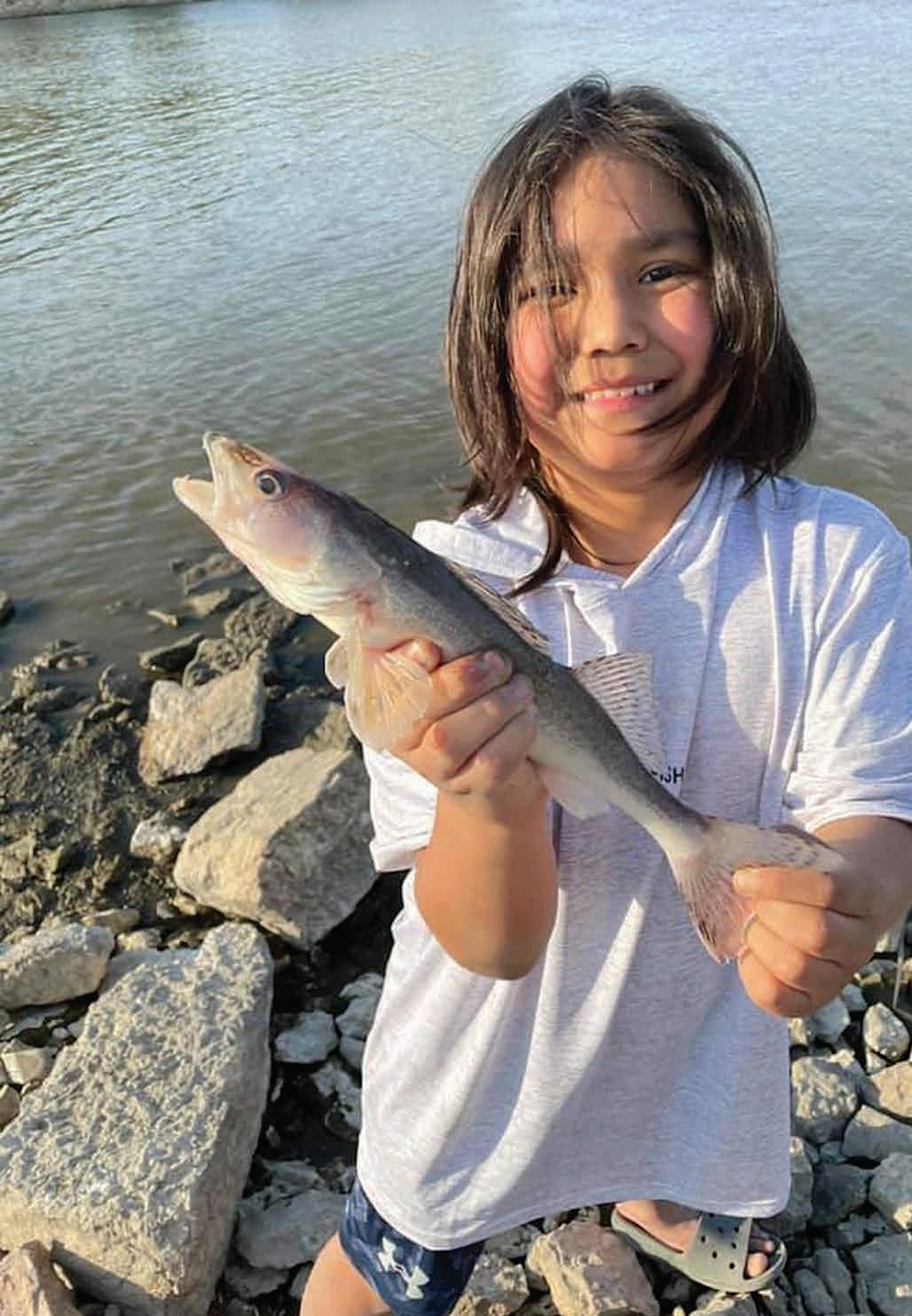
Food allergies and intolerances
Food allergies and food intolerances may be different for different people.
A food allergy is a bodily reaction to a food protein. An allergic reaction can be mild, like watery or itchy eyes, stuffy nose or a skin rash. It can also be more serious, such as stomach pains, cramps, diarrhea or vomiting. The most severe reaction is swelling of the throat, difficulty breathing and shock. Luckily, this is very rare. Talk to your family doctor or community health nurse if you think your child has a food allergy. Call 911 or get medical help right away, if your child is having trouble breathing.
A food intolerance is a digestive reaction to a food. For example, lactose intolerance is a reaction to the milk sugar and lactose found in some dairy products like milk, cheese and ice cream. An intolerance can lead to diarrhea, stomach cramps, runny nose or rash. If you notice your child has any of these signs after eating certain foods, talk to your family doctor or community health nurse about your concerns.
“When they eat nutritious foods, their hunger is satisfied, they are able to focus for longer periods of time and are less grouchy … Adopting or reintroducing garden plants into our diets can have profound health impacts on general wellbeing and for diabetes too.”
-Vanda Fleury-Green
Healthy eating
Children need a variety of healthy foods to eat every day. This includes different kinds of fruits and vegetables, whole grains, foods that are high in protein, and plenty of water to drink. Meals should include foods from 3 or 4 different food groups, and snacks should include foods from at least 2 different food groups. Children also need to be served the right-sized portion of food, which should be just enough to satisfy their hunger, but not too much to make them feel too full and uncomfortable. The following chart shows the number of servings of food that children need from each of the food groups, each day.
Limit processed foods
Processed foods are foods that have been cooked, canned, frozen, packaged, or changed with added unhealthy ingredients like oil, sugar and salt to preserve and partially prepare it for eating. Processed foods typically come in a box or a bag and contain more than one ingredient on the list of ingredients.
Not all processed foods are unhealthy. Some types of processing, like the pasteurization of milk, are necessary to create a safe and convenient food supply for later use. Other methods of processing food, like smoking, drying, canning and freezing, also are a good way to preserve foods that are high in nutrients.
Government of Canada – Limit Highly Processed Foods
food-guide.canada.ca/en/healthy-eatingrecommendations/limit-highly-processed-foods
Government of Canada – Nutrition labelling canada.ca/en/health-canada/services/ understanding-food-labels.html
Every child is different and at times children may be more hungry or less hungry than usual. Let your children decide how much they need to eat to satisfy their hunger without getting too full. When they are hungry between meals, provide healthy snack foods for them, such as fresh fruits and vegetables, cheese with whole grain crackers, or yogurt with fresh berries. For a healthy alternative to sweetened drinks, add a few berries or a slice of lemon or cucumber to naturally flavour your children’s drinking water.
Eating Well with Canada’s Food Guide for First Nations, Inuit and Metis canada.ca/en/health-canada/services/foodnutrition/reports-publications/eating-well-canadafood-guide-first-nations-inuit-metis.html
Explore Canada’s Food Guide – Food Choices, Eating Habits, Recipes, Tips, Resources food-guide.canada.ca/en
Handy Guide to Serving Sizes and Food Portions unlockfood.ca/EatRightOntario/media/PDFs-newwebsite/Portions%20Toolkit/Handy-ServingsGuide-EN-v04a-July-2018.pdf
Cook from scratch
Packaged food costs money and it has a cost to the environment. Making food from scratch, such as burgers, macaroni and cheese, or spaghetti sauce is a good way to save money. Look for healthy recipes that fit your budget, are quick and easy to make, and your family will enjoy. You can find recipes and ideas for cooking family meals on a tight budget through your local library, family resource centres, and the Internet. To find healthy meal ideas that work for you, include in your online search the names of the food items that you have on hand. Cookbooks are another place where you can find delicious, nutritious, easy to prepare, family friendly recipes and cooking tips.
Grow your own food
Growing your own food is a great way to make sure your children have a variety of healthy foods that are packed with vitamins, minerals and antioxidants. It also is a fun way for your family to get outdoors for fresh air, connect with nature, and get physical activity. If you do not have a yard or space outside to make a garden, you can use your porch or balcony to grow herbs, tomatoes and other vegetables. You can also make a garden right inside your home, if your home has natural light coming in from the sun. Dirt, seeds and pots can be low-cost or free. Children like to see how things grow and they like to eat foods that they have grown themselves.
A Community Gardener’s Guidebook – A Month to Month Guide: Covering the Basics of Gardening in Winnipeg gov.mb.ca/inr/pdf/pubs/community_gardener_ guidebook.pdf
Basic Gardening Manual for Northern Manitoba gov.mb.ca/inr/pdf/pubs/mafri-gmnm.pdf
Fruit Crops for Northern Manitoba: A Guide to Planting, Growing and Variety Selection gov.mb.ca/inr/pdf/pubs/mafri-frcrops.pdf
“The best thing I learned about parenting came from a nutritionist speaking at a parenting group. She affirmed that, as parents, it was our role to provide healthy food for our children and choose what went on the plate at meal times, but it was the children’s role to choose what they ate off the plate. This took away the need to monitor how much they ate from each food group, while providing the children a sense of control over their own diet.”
-Kate Rempel
Preserve fresh foods
The less food is processed and the closer it is to its whole and natural condition, the healthier it is to eat. Home preserving is a great way to save money and eat fresh, healthy foods all year round. Your children can help with preserving fresh foods.
Buy or pick fresh fruits and vegetables that are in season, and then freeze them to eat later. Canning is another way to take advantage of foods that are in season. Tomatoes can be canned with herbs and spices. You can use them in meals that you make over the winter. For example, cilantro, green peppers and jalapenos create a base for all Mexican dishes. Adding oregano, basil, garlic, marjoram, rosemary and thyme to tomatoes makes a tasty spaghetti sauce.
Direct Farms Manitoba – Find Local Markets and Farms directfarmmanitoba.ca
Prairie Fruit Growers Association – Find Fruit Farms and Year-Round Local Fruit Products pfga.com
The Basics of Home Canning gov.mb.ca/inr/pdf/pubs/nhfi_basics_canning.pdf
“There is a seed of life that sprouts when we plant our garden. Nurturing it with water and maintaining it so that it grows teaches [children] responsibility.”
-Vanda Fleury-Green



ataatatsiaq means “grandfather” in South Qikiqtaaluk
Drink water
Water is the best drink for you and your children. Water does not cause cavities or contain empty calories, and it is healthy for your body. Set a good example for your children by choosing to drink water instead of drinking coffee, tea, pop or fruit juice.
In some communities, tap water is free and safe to drink. In other communities, there either is no running water or the tap water is not safe to drink. Sometimes, you can boil the water to make it safe to drink. Other times, you need to drink bottled water. There is information available about boil water advisories and the safety of the water in your community.
Drinking Water Advisories in Manitoba gov.mb.ca/sd/water/drinking-water/advisory/ map.html
Be a role model
You are a role model for your children. You can teach your children about healthy eating by following a healthy diet. Have a variety of foods that are high in protein, fiber, and healthy fats. Serve healthy portions of food and let your children decide when they are full. Plan meals, cook, and eat together as a family, at the table and away from the television and cell phones. By showing your children what it means to eat in a healthy way, you help your children develop good eating habits for life.
I celebrate the knowledge and contributions of Indigenous women and girls who traditionally raised gardens and fields. Carving out this space is important because these stories are often left out, devalued. Physical, emotional, and spiritual health and wellness are rooted in resiliency … What we feed our thoughts plays an influential role as well. The roots of my past inspire me to follow my great-grandparents land-based approach to health and wellness. Though my parents do not garden, I feel encouraged to stir up family traditions and sow the seeds of our narratives … Indigenous knowledge of plant cultivation can be carried forward by exploring health justice through gardening. On the local horizon at Kenosewun Park in Lockport is one of the oldest farming sites in Manitoba … the Selkirk Settlers of the 1800’s are often honoured as the first farmers. Giving proper credit to the original farmers of our ancestral lands and territories empowers our youth, and us as parents.
-Vanda Fleury-Green
Traditional and country foods
First Nations, Inuit and Metis peoples’ ways of life have changed over time, including what and when we eat, and how active we are in our daily lives. Many First Nations, Inuit and Metis families today spend a lot of time sitting throughout the day. They do not have easy access to places where they can hunt, gather medicines, pick berries and other edible leaves and grasses, or fish like they did in the past. They also may no longer have this traditional knowledge.

“As Indigenous parents, we can honour the sacred life force through a family garden. Cultivating a sense of togetherness and providing our children with tools to build their self-esteem and cultural pride are vital. Indigenous plant harvesting is a place to ground our youth.”
-Vanda Fleury-Green
Food from the land and water
Traditional and country foods vary by season and community. They are rich in protein and essential vitamins and minerals. Most are low in fat and sugar. Bison, muktuk, deer, caribou, moose, and seal are some of the healthiest foods to eat. Traditional and country foods include fish, wildlife, root vegetables, wildflowers, mosses, grasses, lichens and berry plants. These can include:
• Bison, muktuk, white-tailed deer (venison), elk, moose, caribou and muskox
• Seal, whale, sculpin, clams and mussels
• Bass, jackfish, lake sturgeon, pickerel, walleye, salmon, Arctic cod, Arctic char, capelin and lake trout
• Duck, goose, partridge, prairie chicken, muskrat, rabbit, Arctic hare and ptarmigan
• Blackberries, blueberries, cloudberries, chokecherries, crab apples, cranberries, Saskatoon berries, gooseberries and crowberries
• Beans, carrots, cabbage, green beans, onions and potatoes
• Edible wild plants (i.e., dandelion greens, mountain sorrel, snow-bed willow, lamb’s quarter, violet and shepherd’s purse), hazelnuts, mint leaves, weekay root, wild rhubarb, wild rice and 100% pure maple syrup
Learn about traditional foods
Picking berries is a great way for children to learn about where food comes from. It helps build children’s confidence, identity and cultural pride. Children develop their coordination skills and respect for the land as they pick berries and put them into a pail. They learn patience, since berry picking is a slow process. Sometimes, children pick more berries than adults. Some children eat more berries than they bring home. All children and families can benefit from doing this free and healthy activity together.
Listening to teachings about traditional foods and medicine harvesting is a great way for children to learn about the foods from the land and waters that are safe to eat. They also learn about the value of all plants and animals. Call or drop by your local friendship centre, community health centre, or family resource centre, and ask about traditional Elders or Knowledge Keepers who can share teachings on traditional foods and medicines.
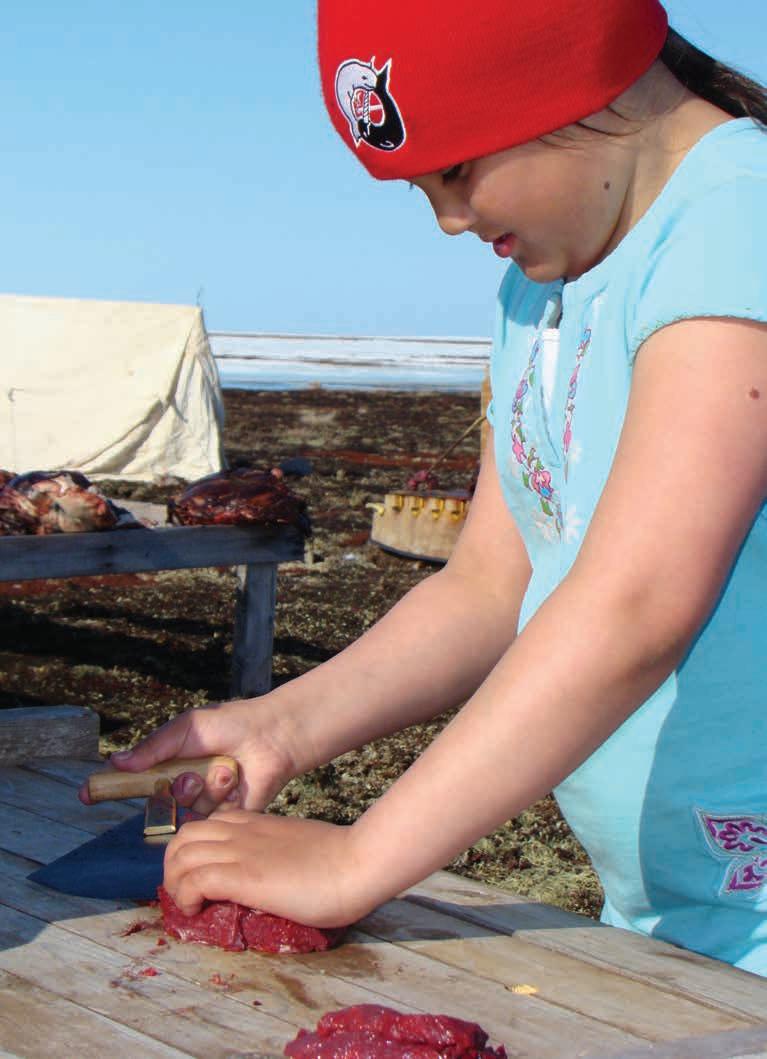
Safe consumption
A traditional diet is low cost if fish and wildlife are available from fishing and hunting. It is important to know how to keep safe and healthy when eating foods from the land and water.
Food Matters Manitoba – Library of Resources foodmattersmanitoba.ca/resources (AN)
Manitoba Wildlife Federation – Hunting, Angling and Trapping Guides mwf.mb.ca/the-mwf/regulations
Mercury in Fish & Guidelines for the Consumption of Recreationally Angled Fish in Manitoba gov.mb.ca/nrnd/fish-wildlife/pubs/fish_wildlife/ fish/mercury_infish.pdf
Metis Laws of the Harvest
mmf.mb.ca/wcm-docs/docs/departmentscitizenship/metis-laws-of-the-harvest_final.pdf
Where to Buy Indigenous Traditional Food in Winnipeg foodmattersmanitoba.ca/wp-content/ uploads/2020/04/Indigenous-Foods-in-Winnipeg2020-edition-Web.pdf
Physical health and safety
You do not need to be an athlete to live an active lifestyle or provide opportunities for your children to be active. Being active can be a part of your everyday life. For example, walking with your children can be done either indoors or outside. Living an active lifestyle with your children can be as simple as choosing to walk or bike to the store, instead of driving or getting a ride.
It can include playing ball, dancing to music on the radio, or swimming. It also can include doing required tasks to prepare for seasonal changes, such as raking and mowing the lawn, gathering and preserving traditional foods, and chopping and gathering wood for winter.
The most important thing about being an active family is remembering to have fun and play together. There are many free programs and activities that you and your children can participate in together, through your local friendship centre, community health and recreation centres, or family resource centres. Most of these activities are offered year-round on a drop-in basis.
Sleeping
Getting the right amount of sleep is another important part of keeping your children physically healthy. School-aged children need about 9 to 11 hours of uninterrupted sleep, each night. Practicing healthy sleep habits like having no screen time an hour before bedtime, brushing their teeth and using the washroom before getting into bed, and turning out the lights at night will help children get the sleep they need to feel well-rested and ready to learn each day.
Canadian 24-Hour Movement Guidelines for Children and Youth: An Integration of Physical Activity, Sedentary Behaviour, and Sleep csepguidelines.ca/wp-content/uploads/2020/11/ CSEP_24HourGuidelines5-17_2016.pdf
National Heart, Lung, and Blood Institute: Physical Activity Tools and Resources nhlbi.nih.gov/health/educational/wecan/toolsresources/physical-activity.htm
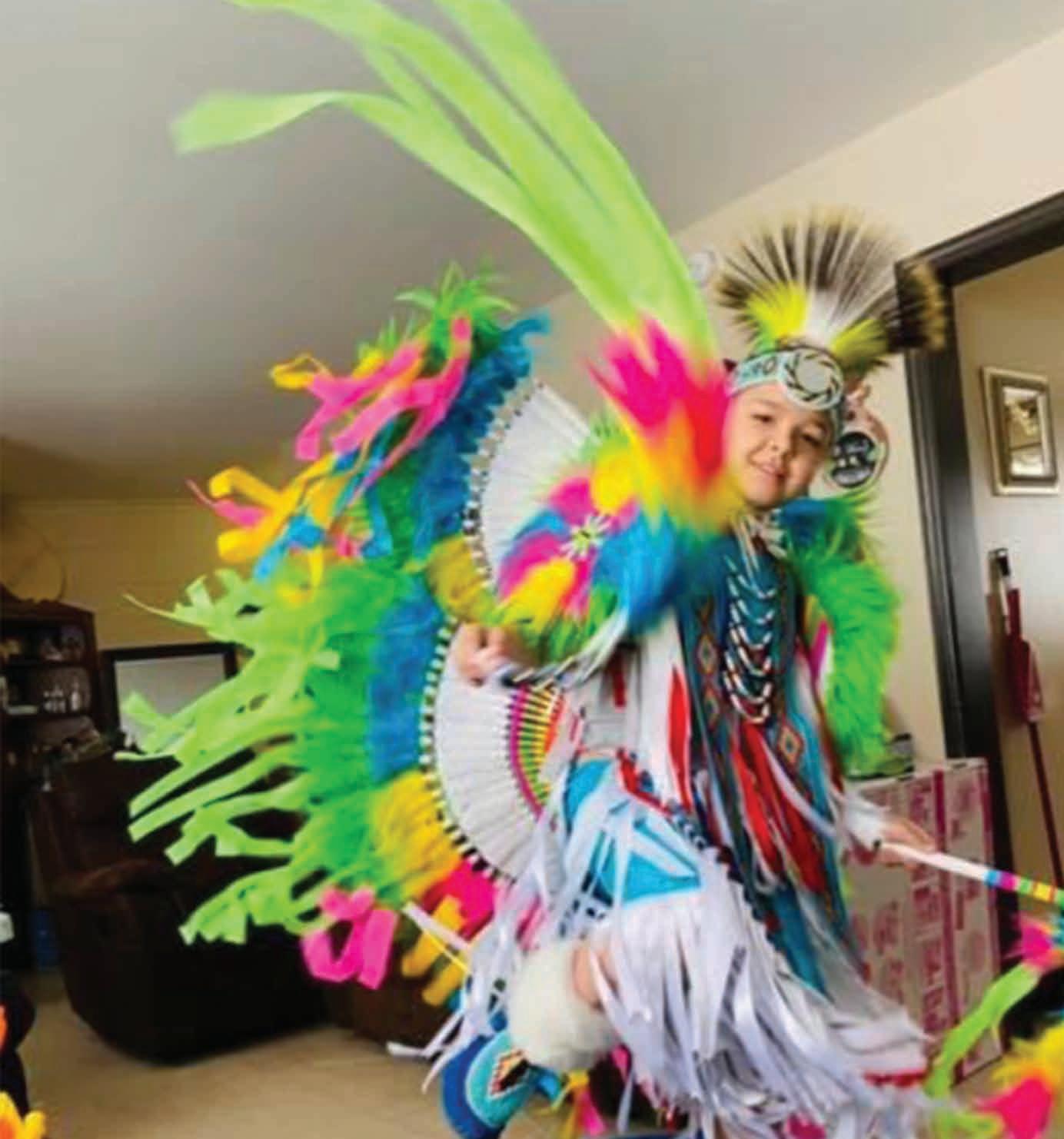
Healthy teeth
Help your children to have healthy teeth. It is important to brush their teeth two times every day. They also should floss between their teeth with dental floss at least once every day. Sweet foods and drinks are not good for your children’s healthy teeth development and can lead to tooth removal or decay. Fixing your children’s teeth sometimes can be a painful experience, for both parents and children.
Taking your children for regular dental check-ups helps to keep your children’s teeth healthy. Children should have their teeth examined by a dentist every six months. In Manitoba, there are places where you can go to get free or low-cost dental services.
Guide to Health and Social Services for Aboriginal People in Manitoba scoinc.mb.ca/wp-content/uploads/2016/06/ Aboriginal-Health-Programs-Guide.pdf
Manitoba Dental/Oral Health gov.mb.ca/health/publichealth/ environmentalhealth/dental.html
Where to go for Dental Care in your Community wrha.mb.ca/wp-content/site-documents/prog/ oralhealth/files/WhereToGo-QuickRef.pdf
Healthy eyes
Vision is one of the most important senses for children. It affects every aspect of children’s learning and development. Eye exams are an important part of making sure children have healthy eyes that are developing properly.
In Manitoba, there is no cost for children (up to 18 years) to get their eyes examined. School-aged children should have their eyes examined by an optometrist every two years.
Guide to vision care benefits for First Nations and Inuit
sac-isc.gc.ca/eng/1579545788749/1579545817396
Manitoba Association of Optometrists –Information on Vision and Eye Health https://www.mb-opto.ca/patients
Immunizations
Immunizations are important because they help keep your children – and you – from getting sick from serious illnesses. Immunizations also help to keep your community healthy by preventing the spread of diseases.
Visit your family doctor, community health nurse, or local medical clinic to make sure you and your children are up to date on their required and recommended vaccinations.
A Parent’s Guide to Vaccination canada.ca/en/public-health/services/publications/ healthy-living/parent-guide-vaccination.html
Routine Immunization Schedules gov.mb.ca/health/publichealth/cdc/div/ schedules.html
Injury prevention
There are many ways children can be harmed. Some examples are choking, animal bites, things falling on them, drowning and burns. The most important things you can do to keep your children safe are to make your home and vehicle as safe as possible and stay close to your children, especially when in, on or around water.
Many children are hurt every year by animal bites. Stay with your children if there are animals nearby that could be a danger to the health and safety of your children. When outdoors, take a repellent if there are problems with stray or wild animals.
Learn what to do if your children choke. It could save their life. Contact your local community health centre, friendship centre, or family resource centre, and ask about any upcoming Emergency First Aid and CPR training opportunities.
Lifesaving Society Manitoba Phone: 204-956-2124 lifesaving.mb.ca
Safety and Injury Prevention gov.mb.ca/healthyschools/topics/safety.html

Technology and online safety
There is no escaping the use of technology. Children today have grown up with the internet and cell phones, online gaming devices and tablets, and other electronic devices. Advances in technology have allowed children to access many new and remote learning opportunities, and to socialize with others through text, virtual talk and social media.
The use of technology has caused concerns with online safety and cyberbullying. As a parent or caregiver, it is important that you are aware, at all times, of the devices your children are using and the online websites they are accessing. You may need to place parental restrictions on these devices and limitations on the amount of screen time you allow for your children.
It is also important to educate yourself and your children about online safety. For example:
• Children should never give out personal information. This includes passwords, usernames, or contact information such as their home address, the school they attend, or even who the people are living in their home.
• Children should only chat or text with people they know – and this should be done in a respectful way.
• Children must be aware that they should only post photos or videos that they would allow their parents to see. They also need to know that photos and videos that are posted on the Internet or in social media outlets can be shared widely, over and over again, without their permission. It is often impossible to delete these images once they have been shared.
• Children should never tease or bully anyone online or be silent about being teased or bullied by others.
Be sure to check in with your children often to see who they have been socializing with online and through social media. Remind your children regularly about practicing safe and respectful behaviour when using technology.
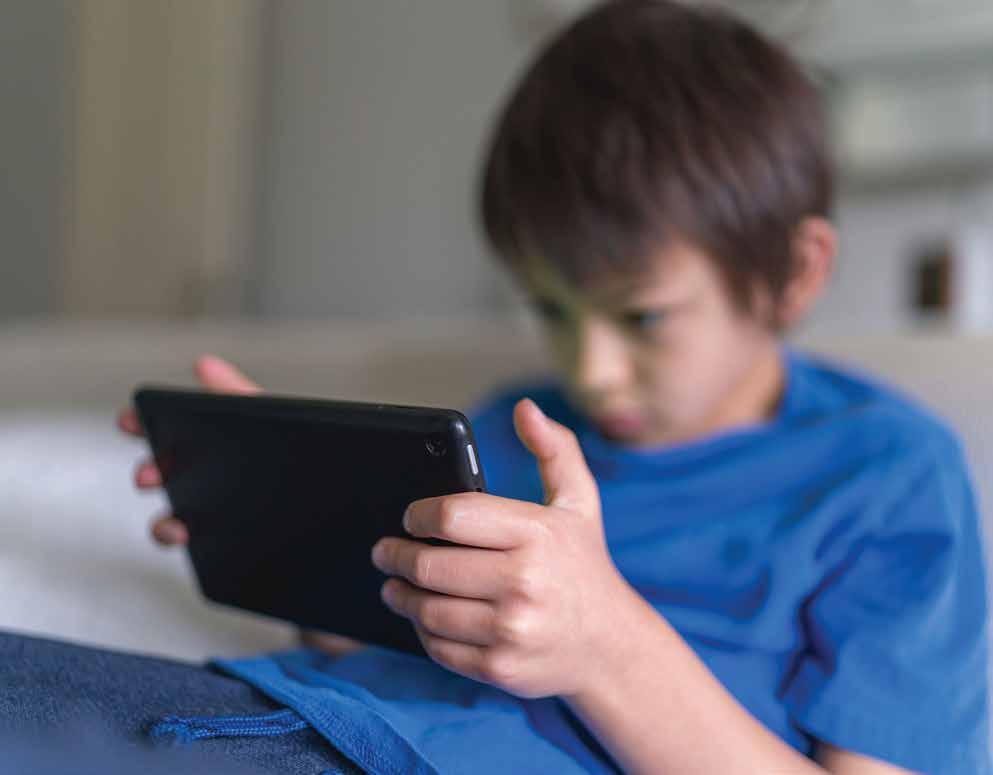
Setting limits for screen time is an important practice for parents of children aged 6-12 years. You may want to set designated times and time limits for your children to use electronic devices. Putting your children’s devices in another room at bedtime may help to limit your children’s screen time.
PREVnet – Cyberbullying
Toll Free: 1-866-372-2495 prevnet.ca/bullying/cyber-bullying
ProtectKidsOnline.ca
Toll Free: 1-800-532-9135 protectkidsonline.ca/app/en
Tracia’s Trust: Manitoba’s Sexual Exploitation Strategy Toll Free: 1-866-345-9241 gov.mb.ca/fs/traciastrust/index.html pearaan means

“parents” in Michif
Puberty
Your children’s body will start to change with the onset of puberty. This can occur at different ages but, generally, puberty begins in the middle years of children’s growth and development. You may notice changes in your children’s voice, skin, weight, body smells, emotions and moods. Each child will go through puberty at their own speed and time.
You and your children may have questions about these changes that are happening, including wanting to know more about menstruation, sexual orientation, or unexpected mood swings. You can support the healthy sexual development of your children by being knowledgeable about the onset of puberty and what to watch for with each stage of your children’s growth and development. There are a number of guides to help you and your children understand what to expect during puberty.
Growing up ok!
gov.mb.ca/healthychild/mcad/growingupok.pdf
Help your children grow up OK! A guide for parenting children through the changes of puberty. A companion to the booklet: Growing up ok!
gov.mb.ca/healthychild/mcad/ helpgrowingupok.pdf
It’s easier than you think! Talking with your children about sexual health and well-being irespectmyself.ca/sites/default/files/documents/ parents_brochure_-_talking_to_your_children.pdf

“Emma was going to a new school. She asked if she could wear one of my bracelets. It helped with her anxiety throughout the day. Anxiety is still something she struggles with, unfortunately. We use breathing exercises, lots of water and healthy foods, and ceremony to help her cope.”
-Leona Huntinghawk

kissaywattisewin means “kindness” in Cree
Positive parenting and self care
Parenting is learned through what you saw, heard and felt throughout your life. Traditionally, parenting was taught throughout life and parents formed strong bonds with their children through the everyday life experiences they shared.
Intergenerational effects
Colonization disrupted Indigenous family and community structures, and interrupted First Nations, Inuit and Metis parents and grandparents from freely passing their spiritual beliefs and cultural parenting practices onto their children and grandchildren. Multiple generations of Indigenous peoples were separated through residential schools, medical institutions, and foster homes. Some First Nations, Inuit and Metis parents may need to heal from their past experiences and learn positive ways to parent.
Choose a path of healing
The best thing about life is that it takes place in the moment. At every moment, you can choose a path of healing. Through culturally-appropriate and safe family support services, the cycle of intergenerational trauma can end. Family circles can be repaired and families can become healthy and strong. Every step that you take toward your own health and healing is a step toward becoming a better parent.
Hope For Wellness Helpline – Online Chat
Counselling Service
Toll Free: 1-855-242-3310
hopeforwellness.ca
Indian Residential Schools Resolution Health Support Program
Toll Free: 1-866-818-3505
Manitoba Farm, Rural & Northern Support Services
Toll Free: 1-866-367-3276 supportline.ca
Manitoba Suicide Line
Toll Free: 1-877-435-7170
reasontolive.ca
Get support
You learn from your own parenting practices and by watching the parenting practices of your parents and grandparents. Elders, aunts, uncles, and other people in your community may be wonderful parenting supports for you. Ask them questions and get parenting tips about how you can raise your children in a healthy way. You can use parent support workshops offered through friendship centres, child and family services agencies, health and wellness centres, and family resource centres throughout your community. These parenting supports can connect you to other parents and help you feel supported in your role as a parent.
Our children are our future. Think about what is best for your children. By working together toward healthier families in healthier communities, you can give your children a bright future that is formed by fond memories of feeling loved and safe as a child. Children remember the teachings that you give them, especially when these teachings are connected to fun and enjoyable moments.

Nurture and care for yourself
In order to love and nurture your children, you need to love and nurture yourself. Giving clear guidance to your children starts with taking good care of yourself. This means staying on top of your own physical, mental, emotional and spiritual well-being. Self-care is important for healthy parenting because it helps to reduce stress, increase resiliency, and prepare you and your children for life’s challenges.
There are many things you can do to keep your mind, body and spirit healthy:
• Connect with people who can love, value and support your own mental, emotional and spiritual needs, such as a caring partner, friend, parent or counsellor. These are the people who can help to build your capacity and confidence as an effective parent.
• Avoid being around people who hurt you and disregard the importance of your feelings.
• Do a physical activity that provides some alone time for personal reflection, like walking or hiking, biking or swimming.
• Beat a drum, listen to music, read a book, or do some journaling.
• Engage in spiritual meditation and connect with your natural surroundings.
• Write down some things you can do to care for yourself.
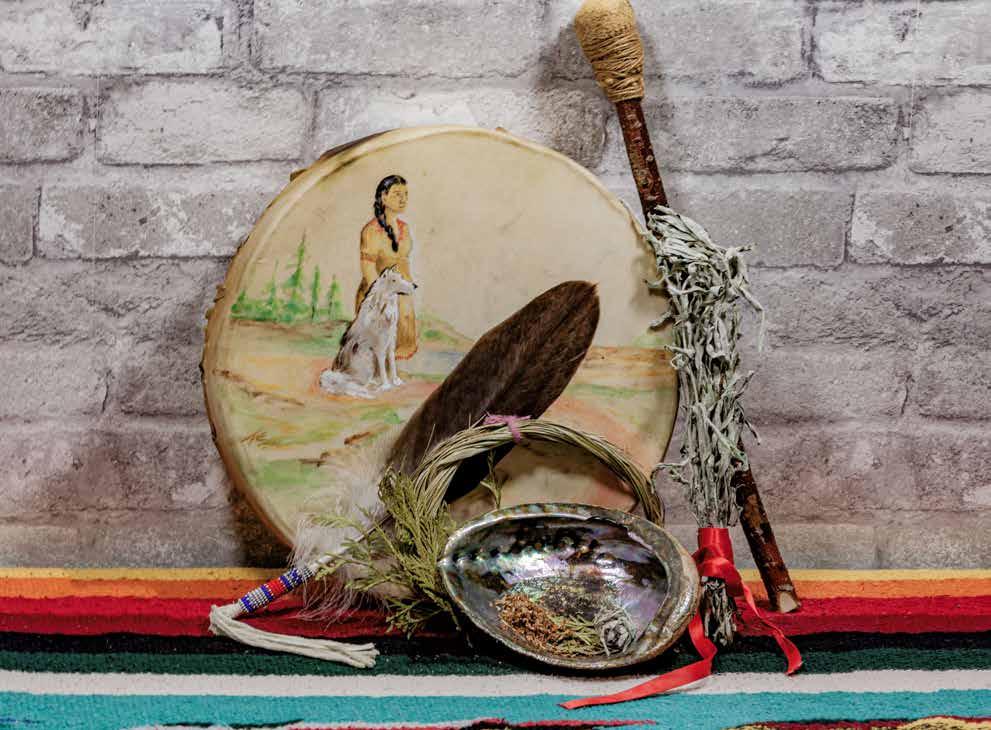
Parent in a good way
No parent starts off knowing all there is to know about parenting, but you can do the best you can to parent your children in a good way. Here are some suggestions:
• Take things one day at a time and don’t give up.
• Share parenting stories with other parents or Elders, and learn from your parenting mistakes.
• Get in touch with your local friendship centre or family resource centre for support with parenting your children.
• Ask your family members, friends or home support worker for help when you need it.
The Culture of Well-Being: Guide to Mental Health Resources for First Nations, Metis and Inuit People in Winnipeg scoinc.mb.ca/wp-content/uploads/2016/06/ MentalHealthGuide.pdf
Get the help you need
All parents can benefit from receiving support in their children’s learning and development. It might be a book about parenting, an auntie who gives you a break, a grandmother with helpful advice, a positive parenting program, or a drop-in centre or family resource centre with helpful resources for parents. Think about what is needed for you to raise healthy, happy, children who are ready for learning.
You can choose to revisit the past when you want to share or reflect on it. Make sure that you are safe and supported if you decide to work through troubling memories. Get the help you need to work through your healing with a counselor, family support worker or Elder. There also may be parenting support programs or counseling resources in your community that can help you with your parenting, healing and self-care.
For more support
There are several organizations in Manitoba that offer a wide range of culturally-appropriate programs, resources and services to help parents and families throughout the province achieve the best possible outcomes for their children. Some of these organizations are listed here:
Aboriginal Health & Wellness Centre of Winnipeg provides a range of cultural-based health and social programs and supports for women, men and families living in Winnipeg.
Phone: 204-925-7504
Email: reception@ahwc.ca ahwc.ca
Anxiety Disorders Association of Manitoba is a peerled organization that shares knowledge and assistance with overcoming the disabling effects of anxiety.
Phone: 204-925-0600
Toll Free: 1-800-805-8885
Email: adam@adam.mb.ca adam.mb.ca
Assembly of Manitoba Chiefs provides program, services and advocacy in several sectors including: child and family services, health, education, citizenship, gaming, Jordan’s Principle, social development, urban and Treaties.
Phone: 204-956-0610
Toll Free: 1-888-324-5483
Email: info@manitobachiefs.com manitobachiefs.com
Child and Family All Nations Coordinated Response Network provides information about programs and services to help families keep their children safe from abuse and neglect.
Phone: 204-944-4200
Toll Free: 1-888-945-2627 ancr.ca
First Nations Family Advocate Office provides support and advocacy for First Nations families involved with the Child and Family Services system.
Phone: 204-957-8450
Toll Free: 1-855-996-9989
Email: fnfao@manitobachiefs.com firstnationsfamilyadvocate.com
First Nations Health and Social Secretariat of Manitoba offers programs and services to support the health and social well-being of First Nations families and communities in Manitoba.
Phone: 204-942-9400
Email: info@fnhssm.com fnhssm.com
First Nations of Northern Manitoba Child and Family Services Authority works to support and empower First Nations Child and Family Services agencies in Northern Manitoba to enhance and enrich family life.
Phone: 204-942-1842 northernauthority.ca
General Child and Family Services Authority is responsible for the administration and provision of child and family services by the agencies and service regions under its jurisdiction.
Phone: 204-984-9360
Toll Free: 1-866-803-2814
Email: generalauthority@gov.mb.ca generalauthority.ca
Manitoba 211
Phone: 2-1-1
Toll Free: 1-855-275-1197
Email: 211mb@findhelp.ca mb.211.ca
Manitoba Advocate for Children and Youth provides advocacy, investigation and review of public services to ensure they are meeting the needs of children, youth and young adults.
Phone: 204-988-7440
Toll Free: 1-800-263-7146
Email: info@manitobaadvocate.ca manitobaadvocate.ca
Manitoba Association of Friendship Centres provides information about the programs and services that are offered at local friendship centres for children and their families.
Phone: 204-942-6299
Email: info@friendshipcentres.ca friendshipcentres.ca
Manitoba First Nations Education Resource Centre provides First Nations-based information and resources to support general learning and educational activities for First Nations children and youth in Manitoba.
Phone: 204-594-1290
Toll Free: 1-866-319-4857
Email: info@mfnerc.com mfnerc.org
Manitoba Inuit Association works to build a vibrant Manitoba Inuit community by connecting Inuit through cultural activities and community initiatives that sustain and build Inuit cultures, values and languages.
Phone: 204-774-6848
Email: info@manitobainuit.ca manitobainuit.ca
Manitoba Keewatinowi Okimakanak Inc. provides advocacy and support to First Nations children, youth and families in Treaty areas 4, 5 and 6, including those who are involved with the child and family services system.
Phone: 204-927-7500
Toll Free: 1-800-442-0488 mkonation.com
Manitoba Metis Federation offers support services, resources, advocacy and referrals to Metis individuals, families, Elders and communities.
Phone: 204-586-8474
Email: info@mmf.mb.ca mmf.mb.ca
Metis Child, Family and Community Services works to strengthen the capacity of families to care for children through culturally appropriate, communitybased, programs and parenting supports.
Phone: 204-927-6960
Toll Free: 1-800-821-8793
Email: info@metiscfs.mb.ca metiscfs.mb.ca
Metis Child and Family Services Authority is responsible for the administration and provision of child and family services by the Metis Child, Family and Community Services Agency and the Michif Child and Family Services Agency.
Phone: 204-949-0220
Toll Free: 1-855-779-1277
Email: info@metisauthority.com metisauthority.com
Mood Disorders Association of Manitoba is a selfhelp organization dedicated to providing support, education and advocacy for those living with mental health illnesses.
Phone: 204-560-1461
Toll Free: 1-800-263-1460
Email: info@moodmb.ca moodmb.ca
Qaumajuq at the Winnipeg Art Gallery offers a large public collection of contemporary Inuit art, as well as stories and programs that welcome, engage and inspire Inuit to celebrate and connect with their cultural heritage.
Phone: 204-876-6641
Email: inquiries@wag.ca wag.ca/about/qaumajuq
Rehabilitation Centre for Children provides services to children aged birth to 18 years with physical and developmental challenges.
Phone: 204-452-4311 rccinc.ca
Sexuality Education Resource Centre Manitoba provides inclusive, non-judgmental, support and education about sexuality.
Phone: 204-982-7800 serc.mb.ca
Southern Chiefs’ Organization works to protect, preserve, promote, and enhance First Nations peoples’ inherent rights, languages, customs, and traditions through the application and implementation of the spirit and intent of the Treaty-making process.
Phone: 204-946-1869
Toll Free: 1-866-876-9701
Email: receptionist@scoinc.mb.ca scoinc.mb.ca
Southern First Nations Network of Care promotes First Nations wellness and ensures the protection of children and youth through the provision of safe homes with responsible caregivers.
Phone: 204-783-9190
Toll Free: 1-800-665-5762 southernnetwork.org
Specialized Services for Children and Youth provides coordinated, regionally-based, services to help children and youth with disabilities and additional needs to reach their full potential.
Phone: 204-452-4311 sscy.ca
Photo Credits
Cover: © iStock ID 157694738
Inside Cover: © iStock ID 485023595
Page 4: © Stephanie Midford
Page 5: © Courtney Bear
Page 6: © Stephanie Midford
Page 7: © Rachel Brown
Page 9: © Jennifer Laviolette
Page 10: © Carla Cochrane
Page 11: © iStock ID 536555281
Page 12: © Lisa Murdock
Page 13: © iStock ID 172210514
Page 14: © Lisa Murdock
Page 15: © Tamara Dionne Stout
Tunngasugit is an Inuit-specific resource centre that works to help Inuit in Manitoba with any situation they may face while transitioning into an urban setting.
Phone: 204-416-8910
Toll Free: 1-844-654-6848
Email: info@tunngasugit.ca tunngasugitinc.ca
The following service portal is designed to help Manitobans find and navigate the programs, services and other resources they need:
Manitoba Residents Online Services Portal
Phone: 204-945-3744
Toll Free: 1-866-626-4862
Email: mgi@gov.mb.ca residents.gov.mb.ca
Page 16: © Leona Huntinghawk
Page 17: © Courtney Bear
Page 18: © Vanda Fleury-Green
Page 19: © Kukik Baker
Page 20: © Mindy Sinclair
Page 21: © Courtney Ducharme
Page 22: © Leona Huntinghawk
Page 23: © Brandy Stevenson
Page 24: © Jason Parenteau
Page 25: © Carla Cochrane
Page 26: © Christine Smith
Page 27: © Tamara Dionne Stout
Page 27: © Kukik Baker
Page 29: © Jason Parenteau
Page 31: © Vanda Fleury-Green
Page 32: © Stephanie Midford
Page 33: © Vanda Fleury-Green
Page 34: © Kukik Baker
Page 35: © Jaynelle Kennedy
Page 37: © iStock ID 1255292233
Page 38: © Leona Huntinghawk
Page 39: © Shyan Johnson-Monkman
Page 40: © Shyan Johnson-Monkman
Back cover: © iStock ID 157694738
For more information:
View and download this booklet online at: manitoba.ca/parenting or nccih.ca
For further information or to obtain additional copies, please contact:

Department of Families
Child and Youth Services Division
4th Floor 777 Portage Avenue
Winnipeg, MB R3G 0N1
Tel: 204-945-6964
Email: cfsd@gov.mb.ca
Web: manitoba.ca/parenting

3333 University Way
Prince George, BC V2N 4Z9
Tel: 250-960-5250
Email: nccih@unbc.ca
Web: nccih.ca

nccih.ca/485/parenting-presentguide-Manitoba.nccih?id=477
